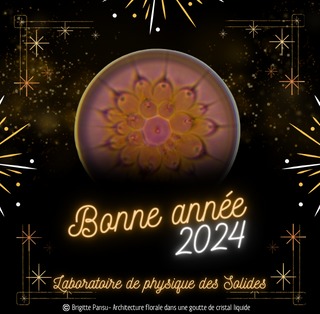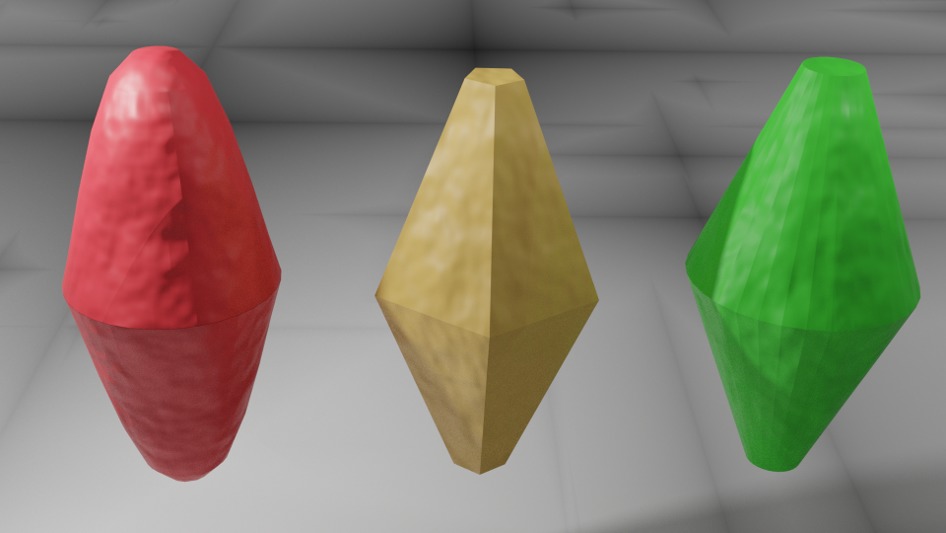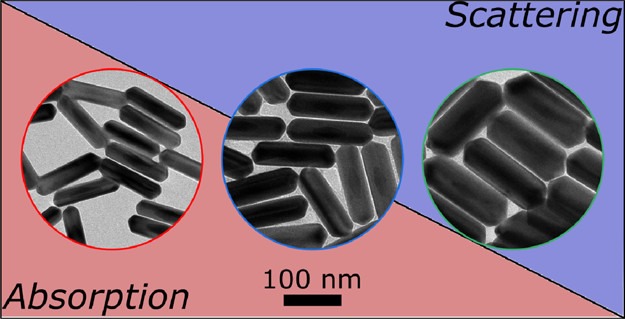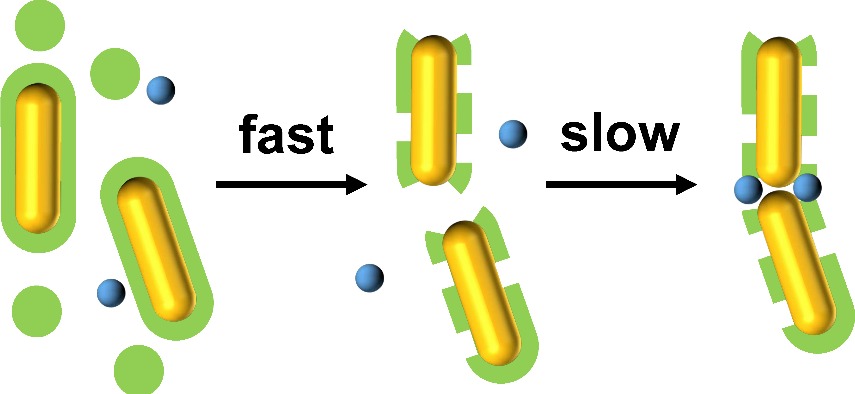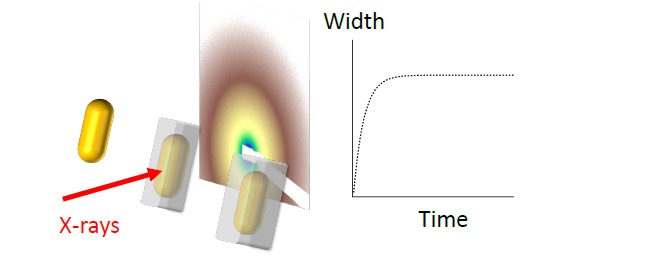Latest News
Congratulation to Dr Marcone!
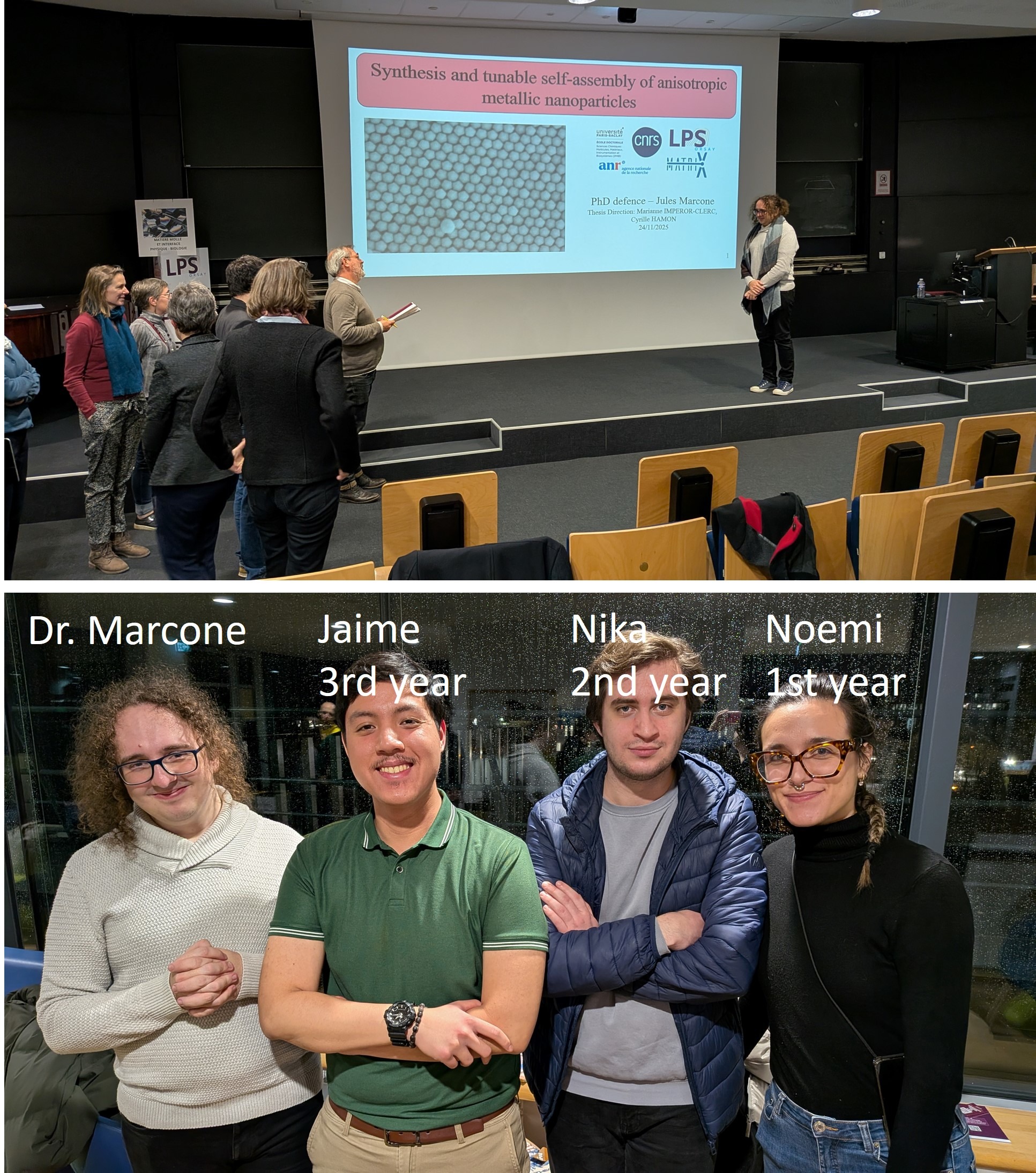 |
24/11/2025 Jules defended his thesis this week and became a Dr. of the University Paris-Saclay after 2h15 of intense discussion with the jury. The jury was composed of: |
Welcome Noemi!
 |
03/11/2025 Noemi Ghelardini obtained her Bachelor’s Degree in Chemistry from the University of Florence (2019–2022), where she worked on the development of molecularly imprinted polymers for the detection of TNF-alpha, using Surface Plasmon Resonance (SPR) as the analytical technique. |
Colloidal Tunable Metasurfaces via Depletion-Induced Self-Assembly of Plasmonic Nanorods
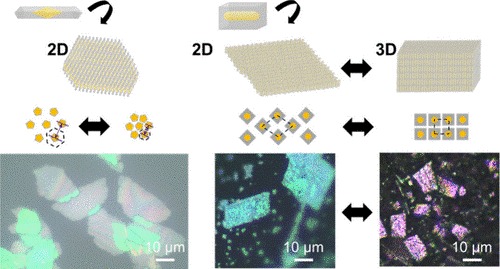 |
03/11/2025 Self-assembly offers a scalable approach to creating nanostructures with tunable properties, particularly for plasmonic materials. Conventional self-assembly often produces dense 3D supercrystals, which restrict light and analyte accessibility. By contrast, directing assembly into 2D metasurfaces increases active surface area and promotes collective optical responses, making them highly promising for sensing and photocatalysis. While metasurfaces are typically immobilized on interfaces, here we introduce the concept of “colloidal metasurfaces”, which are liquid-dispersed and reconfigurable assemblies. Specifically, we exploit depletion-induced self-assembly (DISA) to reversibly organize anisotropic plasmonic nanorods (Au@Ag) into colloidal metasurfaces. By tuning the depletion strength, we achieve dimensional control between 2D and 3D arrangements and modulate the compacity of the colloidal assemblies from 21% to 80%. Assemblies of nanorods with different cross sections reveal shape-dependent reconfigurability: pentagonal rods maintain hexagonal lattice symmetry, whereas square rods undergo symmetry shifts from rhombic to square. These colloidal metasurfaces support multiple assembly–disassembly cycles without loss of optical function and enable modulation of Raman scattering through lattice parameter tuning. Together, this work establishes a functional, reconfigurable colloidal platform for plasmonic metasurfaces using shape-directed DISA. |
Faceted 3D Supercrystals for Plasmonic Photocatalysis: Design, Reactivity, and Operando Studies
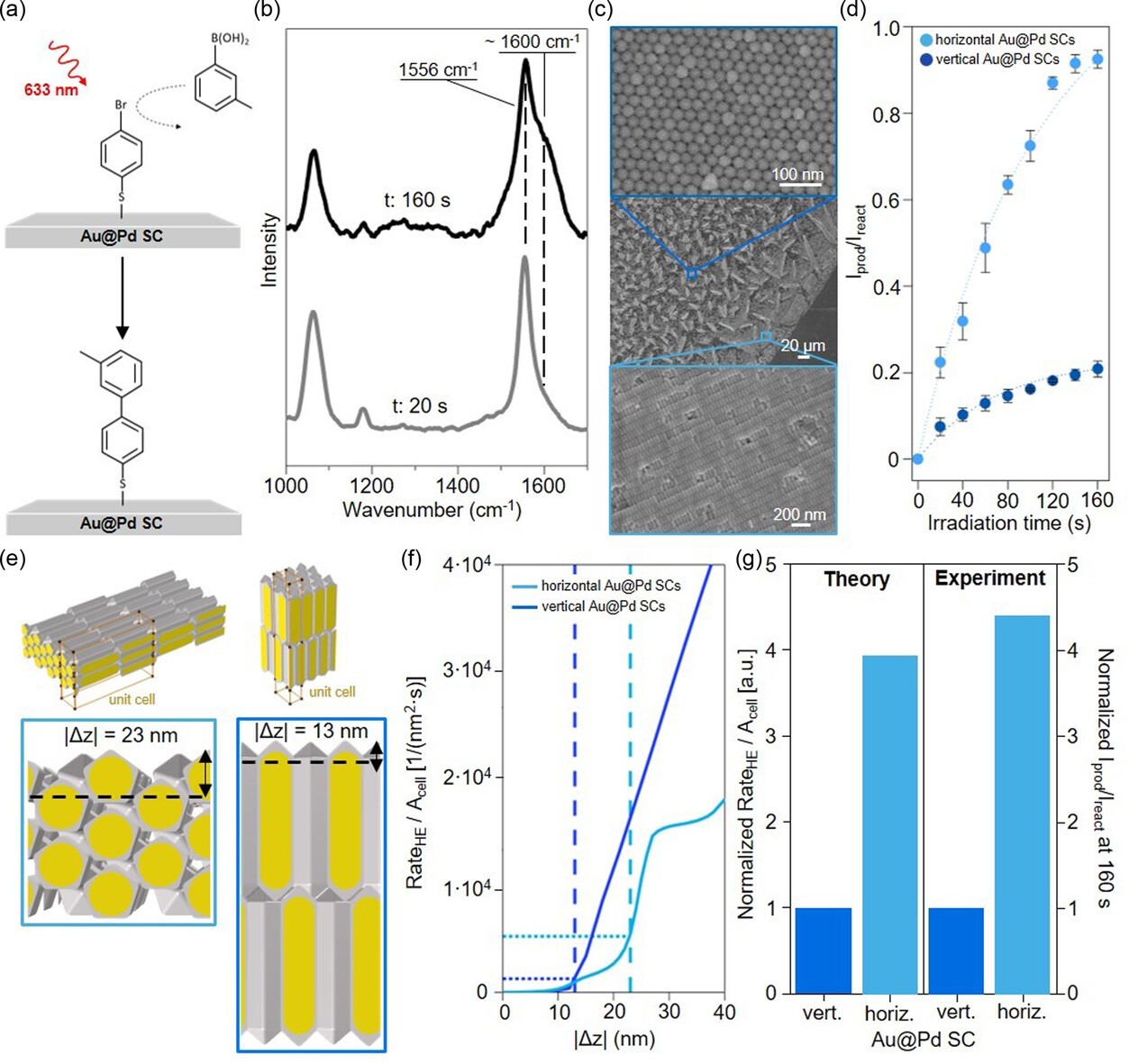 |
13/10/2025 Solar-driven plasmonic photocatalysis has emerged as a powerful tool to enhance chemical reactivity, improving the efficiency and selectivity in a large number of transformations. Plasmonic nanoparticles are often implemented in photocatalysis as colloidal dispersions but they face issues related to the reduced photoactivation ofthe metallic surface in concentrated solutions and poor longterm colloidal stability. To overcome these limitations, 3D plasmonic supercrystals (SCs) created through the depletion- and evaporation-induced self-assembly of metal nanoparticles as novel heterogeneous plasmonic photocatalysts are introduced. They present large electromagnetic field enhancements associated to the formation of regular arrays of plasmonic hot spots, leading to improved chemical reactivities through the generation of hot charge carriers. To demonstrate this, two challenging organic transformations are chosen, an oxidative polymerization and different C─C cross-coupling reactions, that can be activated by modifying the chemical composition of the assemblies. The anisotropic shapes ofthe building blocks lead to the formation of3D SCs exposing different surfaces. Importantly, by performing operando surface-enhanced Raman spectroscopy at the single SC level, the surface-dependent reactivity ofeach individual plasmonic superstructure is unveiled. The combined experimental and theoretical approach provides with key insights into structure-function correlations and offers guidelines for the rational design of versatile SC photocatalysts. This work has been led by Charlène Brissaud and Miguel Comesana Hermo @ ITODYS (Univ. Paris-Cité). DOI: https://doi.org/10.1002/sstr.202500481 |
Strong and Weak Coupling Nanophysics with Free Electron Beams
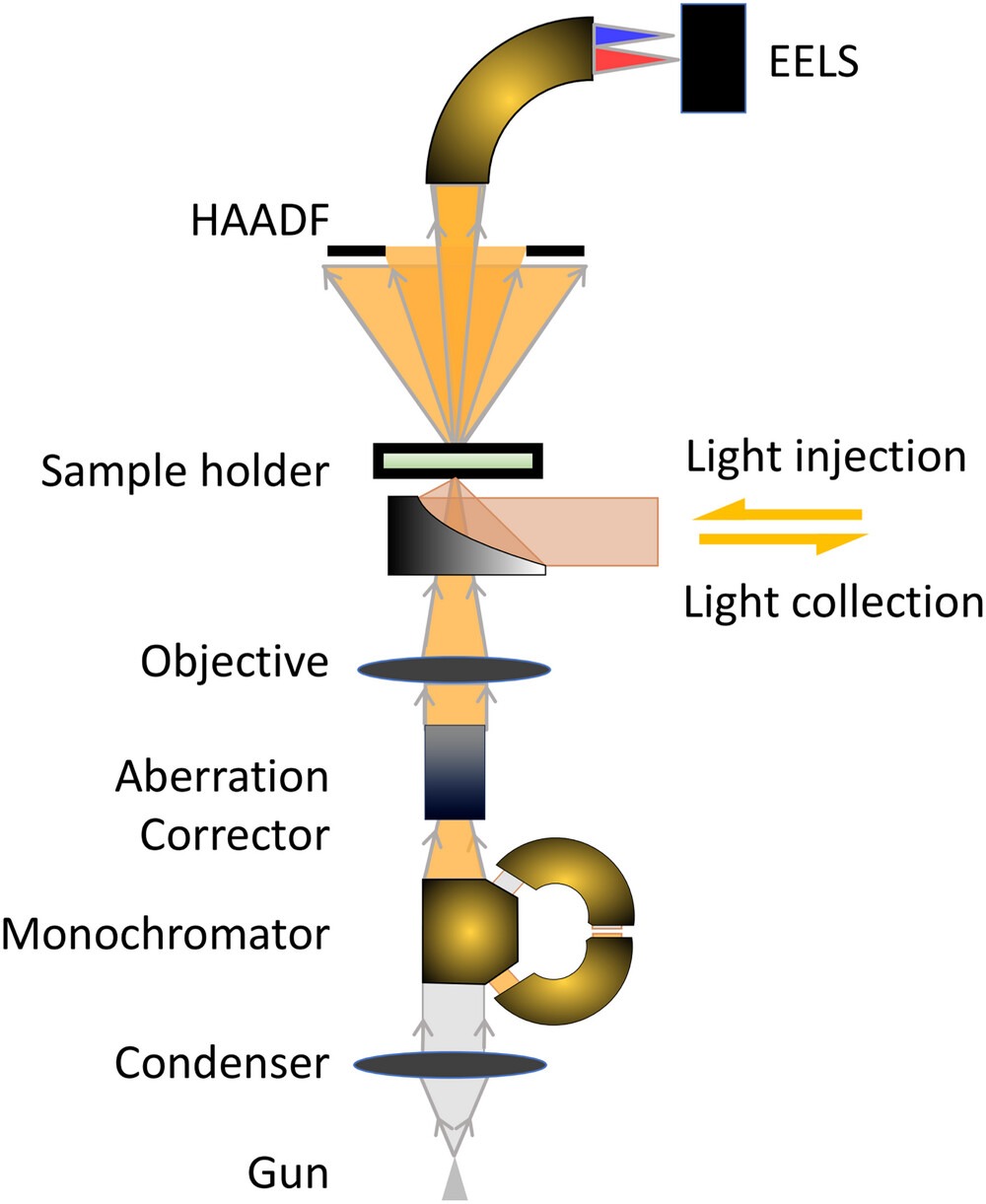 |
29/09/2025, new review article The work of Luis M. Liz-Marzán, his colleagues, and other nanochemists has been essential in the emergence of electron spectroscopies for nano-optics applications. After a brief presentation of these techniques and their applications to individual plasmonic nanoparticles, this paper focuses on a short review of the study of the coupling between optical excitations at the nanometer scale, made possible by recent advances in electron spectroscopies. In particular, plasmon–plasmon, plasmon–exciton, and plasmon–phonon couplings are reviewed. Thanks to Mathieu Kociak and the STEM group for having us! https://doi.org/10.1002/adom.202501548
|
Shaping Light with Reconfigurable Chiral Metafluids
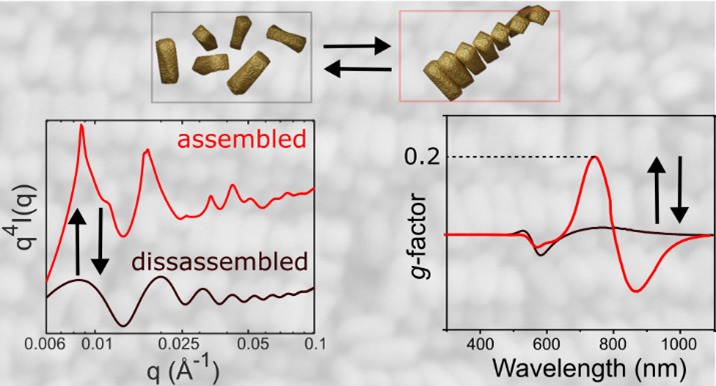 |
Researchers have developed a new way to dynamically control circularly polarized light by self-assembling chiral metallic nanoparticles. This result, at the crossroad between physics and chemistry, offers prospects for the synthesis of materials with new functional properties. At the nanoscale, controlling how light interacts with matter opens the door to technologies such as ultra-sensitive chemical sensors, polarization-based optical data storage, and even new catalysts. One powerful approach is plasmonic circular dichroism (PCD): the ability of tiny metallic structures to interact differently with left- and right-circularly polarized light. Two main strategies exist. One is to make nanoparticles that are themselves chiral so that each particle has its own built-in optical activity. The other is to take achiral particles and arrange them into chiral patterns. Both approaches work, but they have evolved largely separately. Only recently have scientists begun to combine them, aiming to create structures where intrinsic chirality and collective arrangement work together to boost optical responses. The challenge is that while researchers can create strong PCD signals, making them tunable and reversible in real time has proven far more difficult. In this work, we assembled fourfold twisted gold nanorods into higher order chiral architectures, amplifying the PCD response by more than two orders of magnitude compared to isolated nanorods. Using a technique called depletion-induced self-assembly (DISA), we exploit surfactant micelles to control how these twisted nanorods come together in solution. Nanoparticles can be assembled and dissassembled multiple times, allowing the chiral optical response to be switched on and off within the same sample. The PCD signal can reach high dissymmetry factors of around 0.2, while also shifting in wavelength in response to structural changes. This collaborative work between the Universities of Vigo and CIC Biomagune in Spain, the University of Antwerp (Belgium) and the University Paris-Saclay demonstrate that DISA offers a versatile route to build reconfigurable chiral nanostructures with tunable optical properties. The ability to reversibly control the structure and PCD response in liquid “metafluids” opens new opportunities for optical modulators and memory devices. While the current switching times of about one hour are too slow for display or computing technologies, this platform provides a new foundation for designing dynamic chiral materials that can actively manipulate the amplitude, frequency and polarization of light. This work has been published in Chemistry of Materials. Reference Tunable Plasmonic Circular Dichroism of Hierarchical Chiral Assemblies Jaime Gabriel Trazo, Andrés Serrano Freijeiro, Mikhail Mychinko, Nika Kutalia, Marianne Impéror-Clerc, Sara Bals, Luis M. Liz-Marzán, Jorge Pérez-Juste, Isabel Pastoriza-Santos, and Cyrille Hamon DOI : 10.1021/acs.chemmater.5c00909
|
From Low Symmetry to High Dissymmetry: Chiral Plasmonic Films of Binary and Nanobipyramid Assemblies
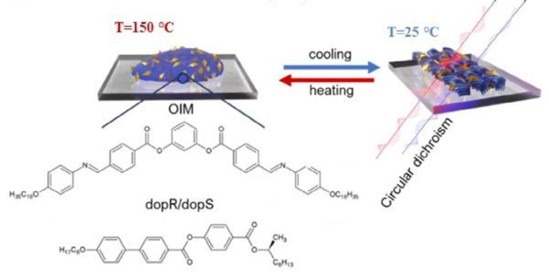 |
27/06/2025 Thin films exhibiting plasmonic circular dichroism (PCD) represent a promising class of materials for technologies based on light processing. However, their potential is limited by the relatively low selectivity of interactions with circularly polarized photons of a given handedness and restricted tunability of the chiroptical properties. This article aims to resolve these problems with two innovations. First, it assembles gold nanobipyramids (NBPs), a promising building block for plasmonics, and arrange them in helical assemblies using a liquid-crystalline (LC) template. By optimizing the organic coating of NBPs, their size, and loading in the thin film, it achieves PCD films with state-of-the-art dissymmetry, g-factor on the order of 10−2. This study unequivocally evidence the properties by Mueller Matrix polarimetry and identify plasmonic coupling between particles as the driving force for the origin of the PCD properties using T-matrix theoretical modeling. Second, spectral and dynamic PCD engineering is achieved by varying particle sizes, co-assembling NBPs with nanospheres, and reversible melting and crystallization of the thin film. Overall, this work unlocks the potential of NBPs and binary assemblies based on NBPs for chiral plasmonics, providing a strategy for thin film materials displaying spectral and temporal PCD response with high dissymmetry factors. Nice collaboration with Wiktor Lewandoswki's lab. See also: https://doi.org/10.1002/adfm.202500933 |
Bridging the Gap between Osmotic and Crystalline Swelling in 2D Layered Materials Using Levitated Dr
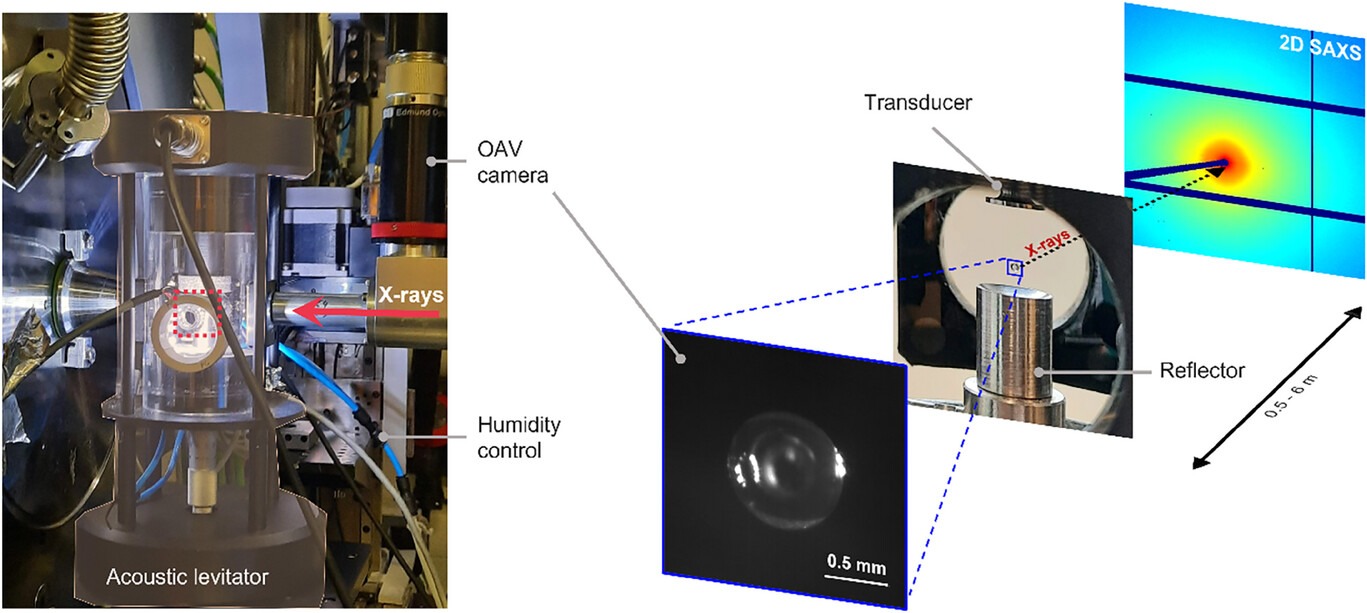 |
24/06/2025 The swelling behavior of smectite clay minerals is known to have two distinct regimes. The crystalline swelling involves the incorporation of a few water sheets between clay layers while the osmotic swelling corresponds to the complete delamination of clay layers in a solvent. Although a linear transition between osmotic and crystalline swellings is proposed, a complete description of smectite swelling has never been achieved. Here, acoustic levitation coupled with Small Angle X-ray Scattering (LevSAXS) is proposed to follow the evolution of the interlayer space of a smectite in a single levitated droplet. The advantage is to track fast non-equilibrium phenomena over a wide concentration range, while avoiding anchoring effects during drying. The results reveal a gradual shift from osmotic to crystalline swelling, marked by a transition from a pure nematic glass to a coexistence zone where the nematic phase contracts and a saturated crystalline phase emerges. This transition occurs through a continuous process, forming interstratified structures ultimately progressing to an unsaturated crystalline state. Applied to the emblematic case of clay swelling, LevSAXS opens new perspectives to investigate or reconsider the swelling mechanisms of other low-dimensional 2D materials. This work have been done notably with Claire Hotton and Erwan Paineau from MATRIX group. see also: https://doi.org/10.1002/smll.202505038 |
Matrix pic nic 2025
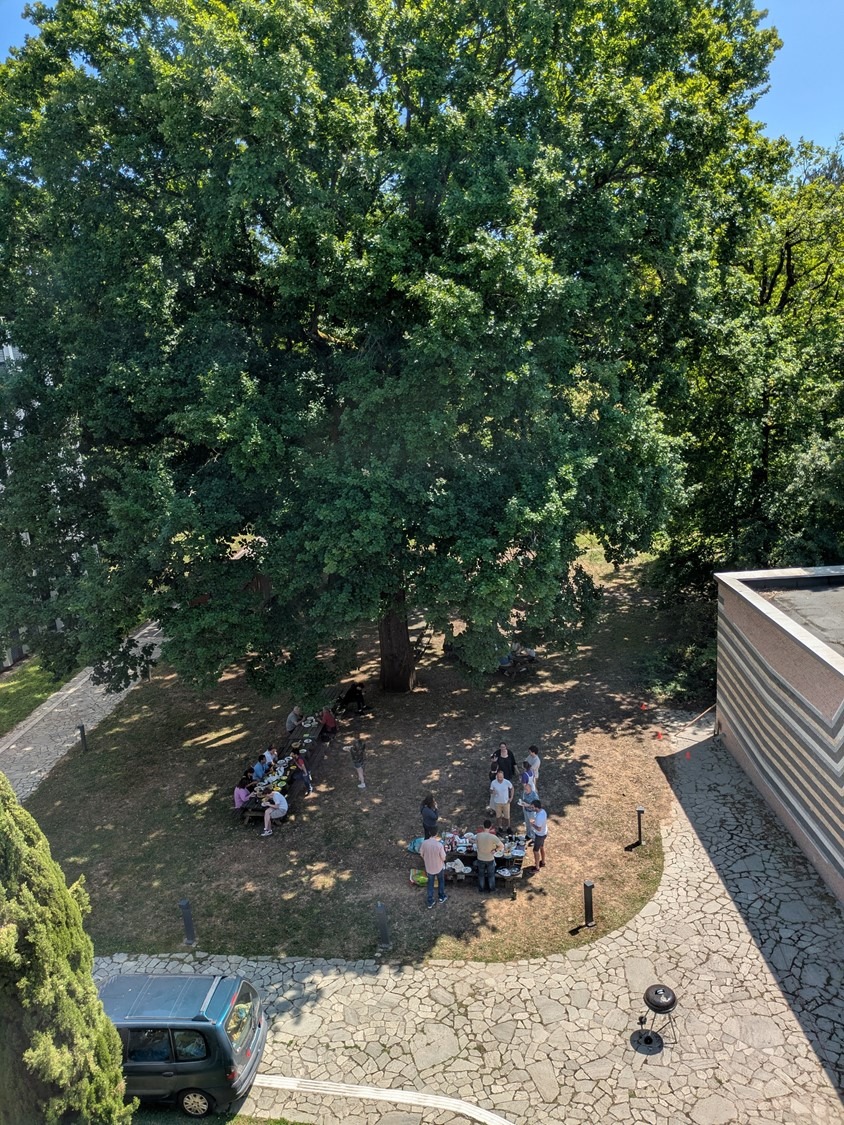 |
18-06-2025
Today was the traditional annual MATRIX pic nic with the permanent and non-permanent members of the team. On this picture taken on high ground, you can appreciate the large oak tree of the lab. 2nd year PhD students organized this event: Thanks Lucie and Jaime! Next event will be in two weeks but this time with the whole lab. |
Plasmonic Polymorphs by Combining Shape Anisotropy and Soft Interactions in Bipyramid Thin Films
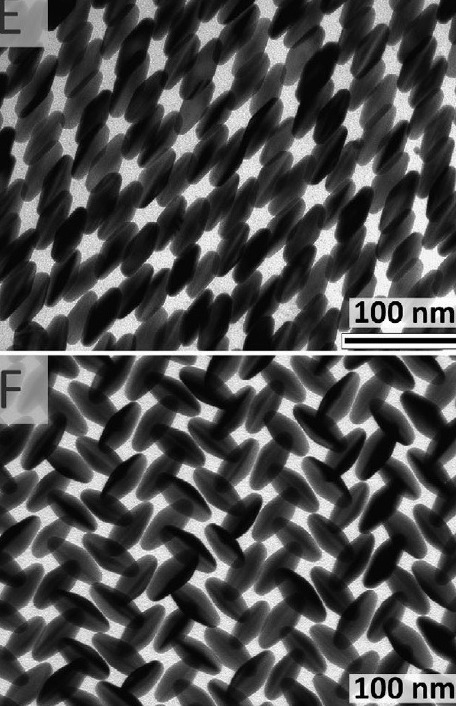 |
02/06/2025 Thin-film plasmonic supercrystals of pentagonal gold nanobipyramids (AuBP) exhibit a diverse range of packing structures that influence the near-field distribution of the enhanced electric field and the far-field response. By varying the molecular weight of the coating ligands, the softness of the anisotropic building blocks is changed. A thorough structural characterization reveals that this affects the resulting superstructures from self-assembly more intricately than with isotropic building blocks. Softer coatings lead to smaller aligned domains in monolayers, while bilayers exhibit more crystalline domains with dominant interlayer twist angles near 0° and 90°. The far-field distribution and near-field response are measured using micro-absorbance and electron energy loss spectroscopy (EELS). Correlating these data with high-resolution transmission electron microscopy (HR-TEM) structural analysis enabled the identification of the longitudinal and transverse individual and collective plasmonic modes. Notably, for large crystalline bilayer domains, a strong polarization-dependent optical response is observed. These features underline the potential of these superstructures for applications in surface-enhanced spectroscopies, plasmonic photocatalysis, and advanced optical manipulation in switchable optical metamaterials. Nice collaboration with self-assembly experts (Florian Schulz), specialists in optics (Stephanie Reich) and electron spectroscopy (Mathieu Kociak). see also: https://doi.org/10.1002/smll.202500389 |
GOLD 2025
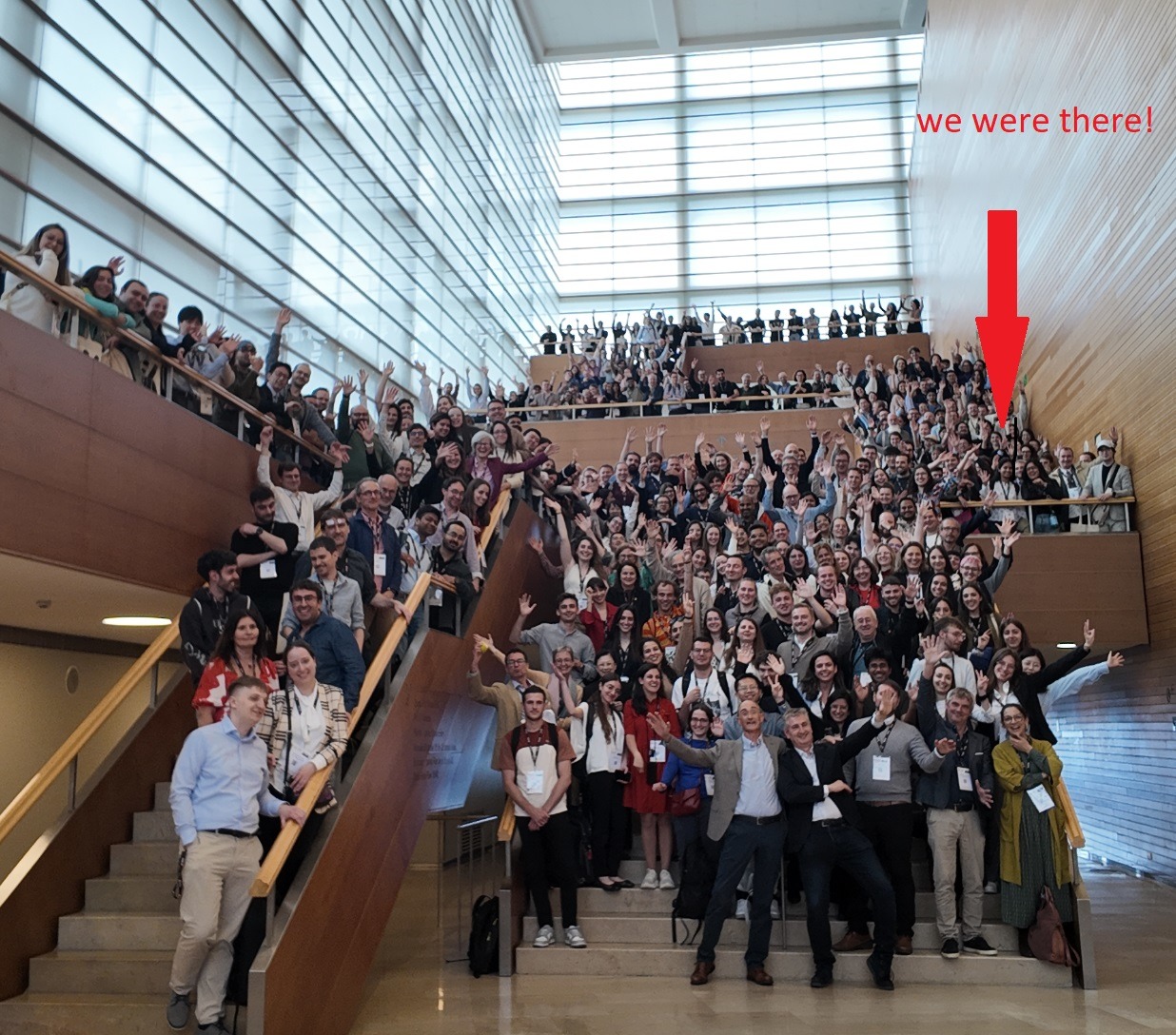 |
15/05/2025 The gold 2025 conference in San Sebastian just ended. It was nice to meet with golden people! |
Co-Solvent-Aided Opto-Thermophoretic Printing of Gold Nanorod Assemblies
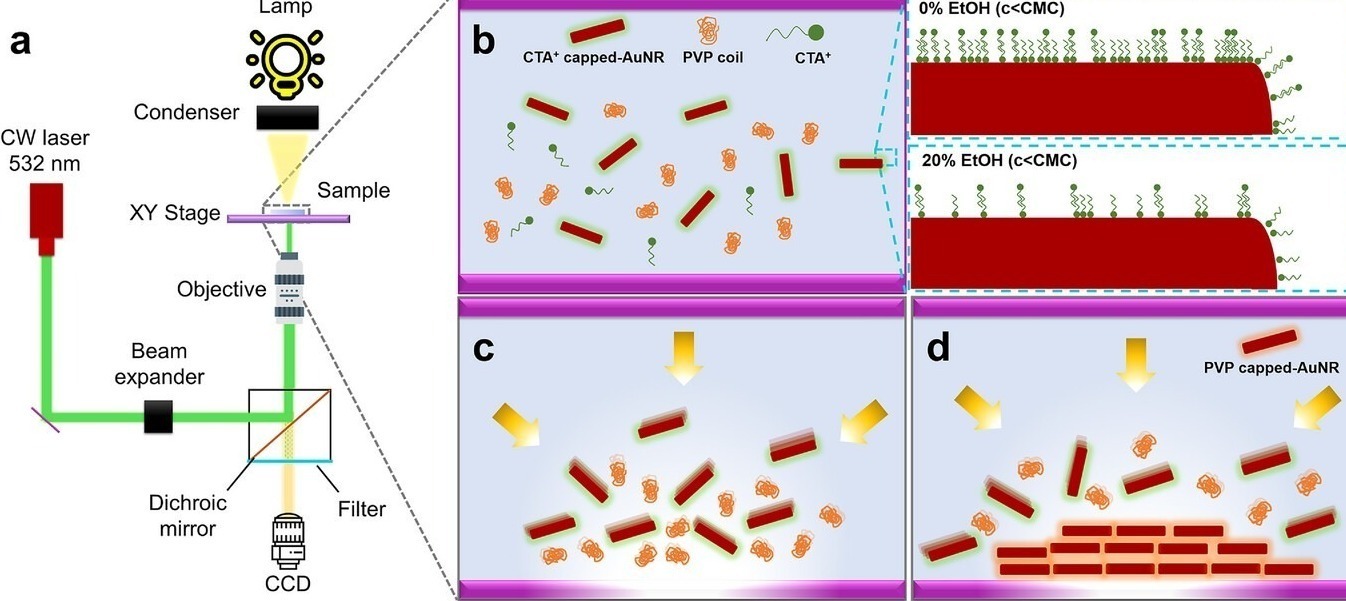 |
24/04/2025. Nice paper from Hill group! The controlled deposition of plasmonic nanoparticles on solid surfaces is critical for the fabrication of medical diagnostics, devices, and sensors. Despite recent advances in harnessing thermal gradients to achieve controlled deposition of nanoparticles at a laser spot, the deposition of anisotropic gold nanoparticles by this approach is a challenge in aqueous solution. Herein, the use of ethanol as a co-solvent is shown to enable rapid (<10 s) and effective deposition of gold nanorods in the presence of polyvinylpyrrolidone on unmodified glass substrates. The influence of key parameters, including polymer concentration and molecular weight, co-solvent content, nanoparticle concentration, and laser power, is studied. While ethanol content and polymer size have the largest impact on the assembly structure, all have an impact on the assembly growth rate. Polymer size is found to significantly impact the degree of nanorod assembly found in the pattern, which leads to a surface-enhanced Raman scattering enhancement factor up to 108. In summary, this approach utilizes thermal gradients to direct the formation of highly localized plasmonic assemblies without the need of functionalization of the substrate. This simple, fast, and adaptable approach is a promising platform for the scalable patterning of plasmonic nanostructures. Nice collaboration with Eric Hill's group! |
A topological approach to model the form factor of prisms - well done Jules!
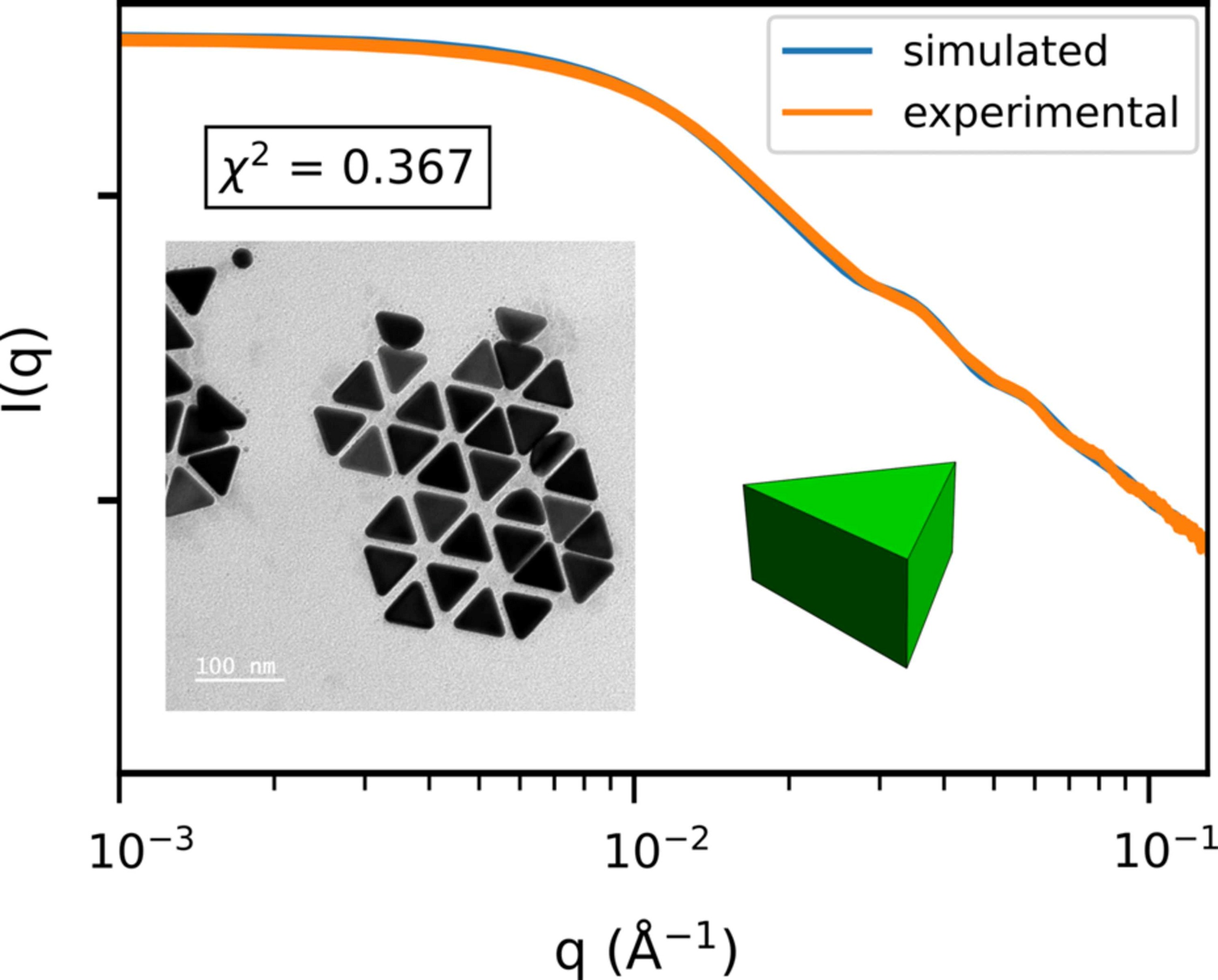 |
11/03/2025 Since the morphology of nanoparticles directly influences many of their properties, accurately determining their shape is crucial for targeted applications. In this work, we focus on nanoprisms due to their widespread use and the limitations of direct imaging techniques in accurately describing their polygonal cross section. Specifically, we introduce a new tool for small-angle scattering (SAS) analysis of nanoprisms that requires minimal computation time compared with all-atom simulations and other form factor analyses. A key innovation in this work is the implementation of the Lebedev quadrature for isotropic averaging, which allows for accurate form factor calculations using few sampling points. This form factor model is developed for any n-sided prism and is compared with small-angle X-ray scattering and transmission electron microscopy experimental data for gold and/or silver nanoprisms (n = 3, 4, 5). For small sizes, the nanoprism form factor model is compared with the result obtained with the Debye equation from atomic coordinates, showing a very good agreement. We explore the effects of the aspect ratio and cross-sectional shape of the nanoprisms on the form factor curves and discuss the limitations of our approach. Overall, our method combines precise shape determination with rapid computation time, paving the way for detailed characterization of nanoprisms using SAS techniques, potentially even during their growth. See Marcone et al. Journal of Applied Crystallography: https://doi.org/10.1107/S1600576725000676 |
welcome Sébastien!
01/02/2025
 |
I graduated in 2023 from a double bachelor’s degree in Physics and Chemistry, at Université Paris Cité. Following this, I pursued a master’s degree in Chemistry, specializing in Chemistry for Energy and Nanosciences. During my studies, I learned various skills in nanoparticle synthesis and characterization. Thus in 2025, I joined the Matrix team at the LPS for my M2 internship where I am investigating the growth of colloidal crystals through microfluidic channels and studying the kinetics of their self-assembly. My internship is supervised by Dr. Cyrille Hamon, Dr. Marianne Impéror-Clerc and Jaime Gabriel Trazo. |
No need to hit the iron while it’s... small!
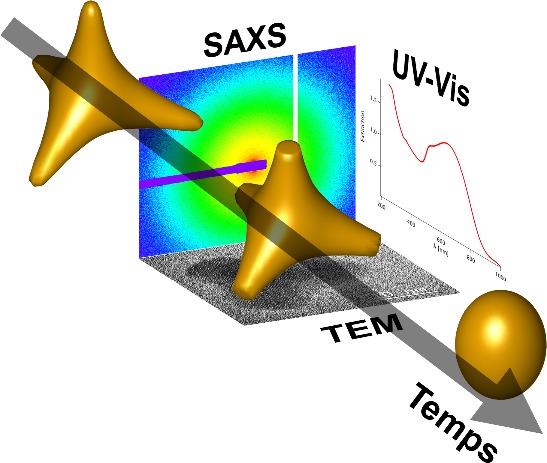 |
14/01/2025 Scientists from CNRS have studied the shape evolution of gold nano-tetrapods and revealed a two-step kinetics process: the four arms—initially sharp—quickly blunt, followed by a slow retraction towards an almost spherical final shape. Deforming macroscopic metallic objects requires considerable force. At the nanoscale, however, things are quite different: surface forces alone are often sufficient to reshape nanoparticles, guiding them towards the most energetically favorable form. Understanding this "nano-metallurgy" is crucial not only for advancing fundamental knowledge but also for driving progress in nanotechnology. Yet, the processes involved are challenging to monitor in real-time. A team of researchers from several French and European laboratories [1] recently published a detailed study in Nano Letters on the transformation pathway of metastable gold particles, initially featuring four sharp arms, into nearly spherical particles. Thanks to their well-defined geometry, these "nano-tetrapods" are easier to study than "nanostars," which have similar characteristics but more varied morphologies. By combining electron microscopy, X-ray scattering, optical spectroscopy techniques, and advanced data processing, the researchers uncovered a complex kinetic process. This begins with a rapid flattening of the tips towards a {110} facet of gold’s crystalline lattice, followed by a slower reshaping phase into an isometric form. Beyond the conceptual understanding of their evolution, this study will enable the use of these nano-objects in nonlinear optical applications [2], thanks to their unique shape, which lacks a center of inversion. [1] Damien Alloyeau at Laboratoire Matériaux et Phénomènes Quantiques, (Université Paris Cité/CNRS), le Laboratoire de physique des solides (CNRS/Université de Paris-Saclay), Doru Constantin at l'Institut Charles Sadron (CNRS/Université de Strasbourg) and the European synchrotron ESRF (Grenoble). [2] Jieli Lyu et al., Shape-Controlled Second-Harmonic Scattering from Gold Nanotetrapods, J. Phys. Chem. C 126, 9831-9835 (2022). Reference : Jieli Lyu et al., Two-step reshaping of acicular gold nanoparticles, Nano Letters (2025). DOI: 10.1021/acs.nanolett.4c05601
See also highlight by CNRS Chimie: https://www.inc.cnrs.fr/fr/cnrsinfo/mieux-comprendre-la-nano-metallurgie-pour-faire-progresser-les-technologies |
Depletion-Induced Tunable Assembly of Complementary Platonic Solids
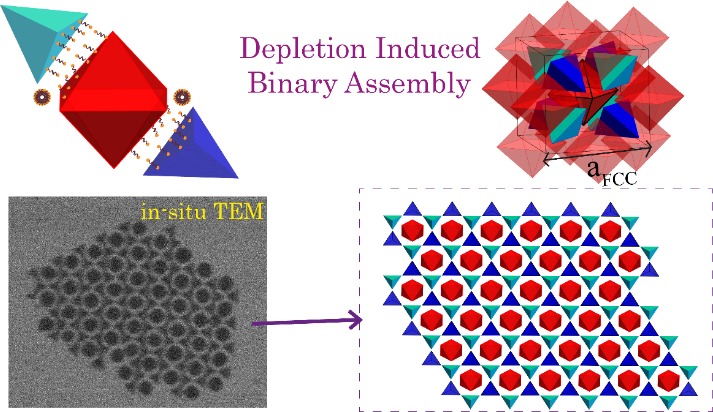 |
13/12/2024 Multicomponent self-assembly has been explored to create novel metamaterials from nanoparticles of different sizes and compositions, but the assembly of nanoparticles with complementary shapes remains rare. Recent binary assemblies were mediated by DNA base pairing or induced by solvent evaporation. Here, we introduce depletion-induced self-assembly (DISA) as a novel approach for constructing tunable binary lattices. In situ structural analysis in the real and the reciprocal spaces demonstrates DISA of a binary mixture of octahedra and tetrahedra into extended supercrystals with Fm m symmetry. The inter-particle distance, adjustable by depletant concentration, offers a versatile method for assembling nanoparticles into ordered structures while they remain dispersed in a liquid phase. We show that DISA can control the packing fraction of such binary supercrystals between φ=0.37 and φ=0.66, much lower than dense packing in the dry state. These findings highlight DISA’s potential for creating complex and highly ordered metamaterials with tailored properties. Long term collaboration with ICS (Strasbourg) and MPQ (Paris) laboratories https://doi.org/10.1021/acs.nanolett.4c04923 |
Anisotropic Thermal Transport in Tunable Self-Assembled Nanocrystal Supercrystals
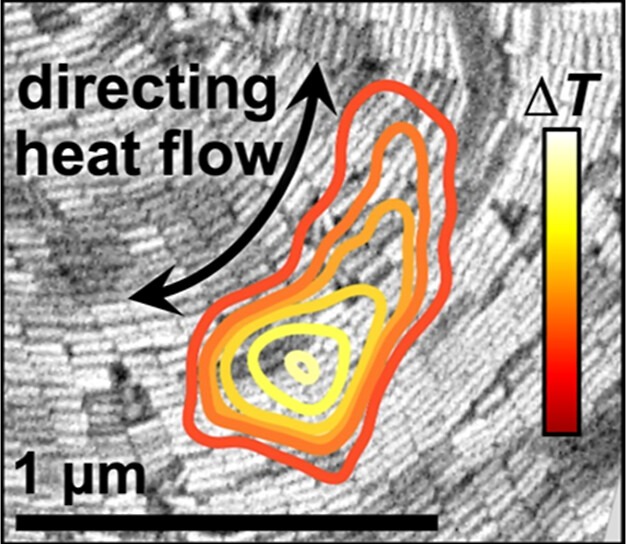 |
01/12/2024 Realizing tunable functional materials with built-in nanoscale heat flow directionality represents a significant challenge that could advance thermal management strategies. Here we use spatiotemporally resolved thermoreflectance to visualize lateral thermal transport anisotropy in self-assembled supercrystals of anisotropic Au nanocrystals. Correlative electron and thermoreflectance microscopy reveal that nano- to mesoscale heat predominantly flows along the long-axis of the anisotropic nanocrystals, and does so across grain boundaries and curved assemblies while voids disrupt heat flow. We finely control the anisotropy via the aspect ratio of constituent nanorods, and it exceeds the aspect ratio for nanobipyramid supercrystals and certain nanorod arrangements. Finite element simulations and effective medium modeling rationalize the emergent anisotropic behavior in terms of a simple series resistance model, further providing a framework for estimating thermal anisotropy as a function of material and structural parameters. Self-assembly of colloidal nanocrystals promises an interesting route to direct heat flow in a wide range of applications that utilize this important class of materials. Nice collaboration with James Utterback (Sorbonne University) and coworkers from other labs. https://doi.org/10.1021/acsnano.4c12991
|
Elucidating Supercrystal Mechanics and Nanoparticle Size and Shape Effects under High Pressure
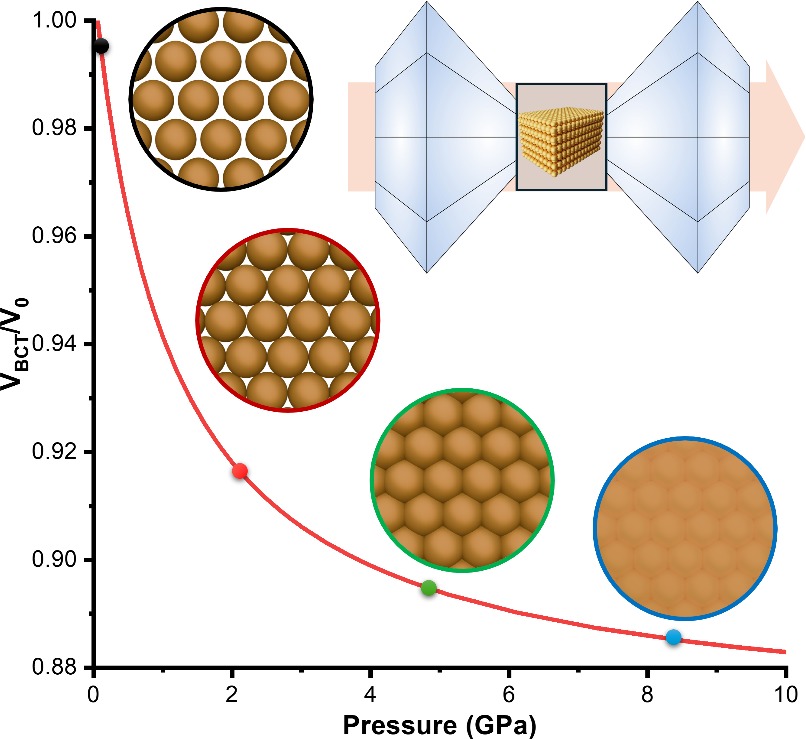 |
01/10/2024 Supercrystals, extended lattices of closely packed nanoparticles (NPs), present exciting possibilities for various applications. Under high pressures, typically in the gigapascal (GPa) range, supercrystals undergo significant structural changes, including adjustable inter-particle distances, phase transformations, and the formation of new nanostructures through coalescence. While prior research has focused on ligand engineering's impact on supercrystal mechanical response, the influence of NP shape remains unexplored, especially for NPs larger than 10 nm coated with hydrosoluble ligands. This study examines the effects of NP shape on the mechanical properties of supercrystals using high-pressure small-angle X-ray scattering (HP-SAXS) and focused ion beam-scanning electron microscopy (FIB-SEM) tomography. Notably, supercrystals exhibit higher hardness levels compared to previously reported values for gold supercrystals, attributed to the use of larger nanoparticles. Spherical and tetrahedral NPs rearrange before collapsing under pressure, whereas rods and octahedra coalesce without prior structural rearrangement, likely due to their higher packing fraction. Additionally, anisotropic deformation of NP lattices and sintering does not always correlate with deviatoric stresses. These findings refine the understanding of complex processes governing supercrystal structure under high pressure, opening new avenues for NP engineering and advancing plasmonic applications under extreme conditions. Nice collaborative work! DOI: 10.1002/sstr.202400303 |
First results on the use of accoustic levitation published
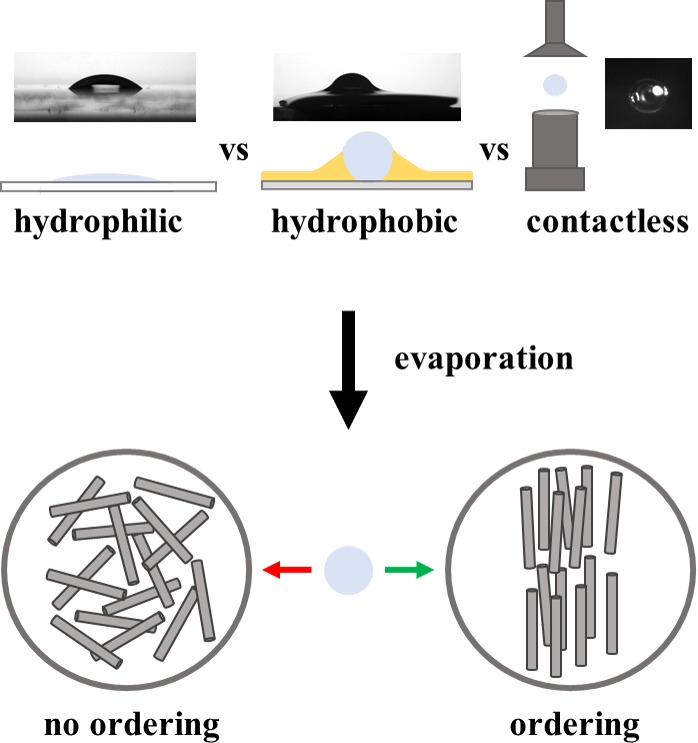 |
17/10/2024. See article in open access here: https://onlinelibrary.wiley.com/doi/full/10.1002/admi.202400323 Highlight on the LPS website: https://equipes2.lps.u-psud.fr/matrix/droplet-levitation-for-self-assembly-of-liquid-crystals/ Highlight on SOLEIL website: https://www.synchrotron-soleil.fr/fr/actualites/levitation-de-gouttes-pour-lauto-assemblage-de-cristaux-liquides Evaporation-induced self-assembly (EISA) is a versatile method for generating organized superstructures from colloidal particles, offering diverse design possibilities through the manipulation of colloid size, shape, substrate nature, and environmental conditions. While some work highlighted the potential of EISA to investigate phase transitions of inorganic liquid crystals, the influence of sample environment to determine their phase diagrams is often overlooked. In this work, we compare the self-assembly of lyotropic liquid crystals by EISA on hydrophilic or hydrophobic substrates, and by acoustic levitation (absence of substrate). We focus on imogolite nanotubes, a model colloidal system of 1D charged objects, due to their tunable morphology and rich liquid-crystalline phase behavior. We demonstrate the feasibility to obtain phase transitions in levitating droplets and on hydrophobic substrate, whereas self-assembly was limited on hydrophilic supports. Moreover, the aspect ratio of the nanotubes proves to be a pivotal factor, influencing both transitions and the resulting materials shape and surface. Besides material shaping, acoustic levitation emerges as a promising method for studying phase transitions by EISA, toward the rapid establishment of phase diagrams from diluted to highly concentrated states using a limited volume of sample. |
Jaime won ECIS-Enzo Ferroni Award for Best Oral Presentation in the young researchers category
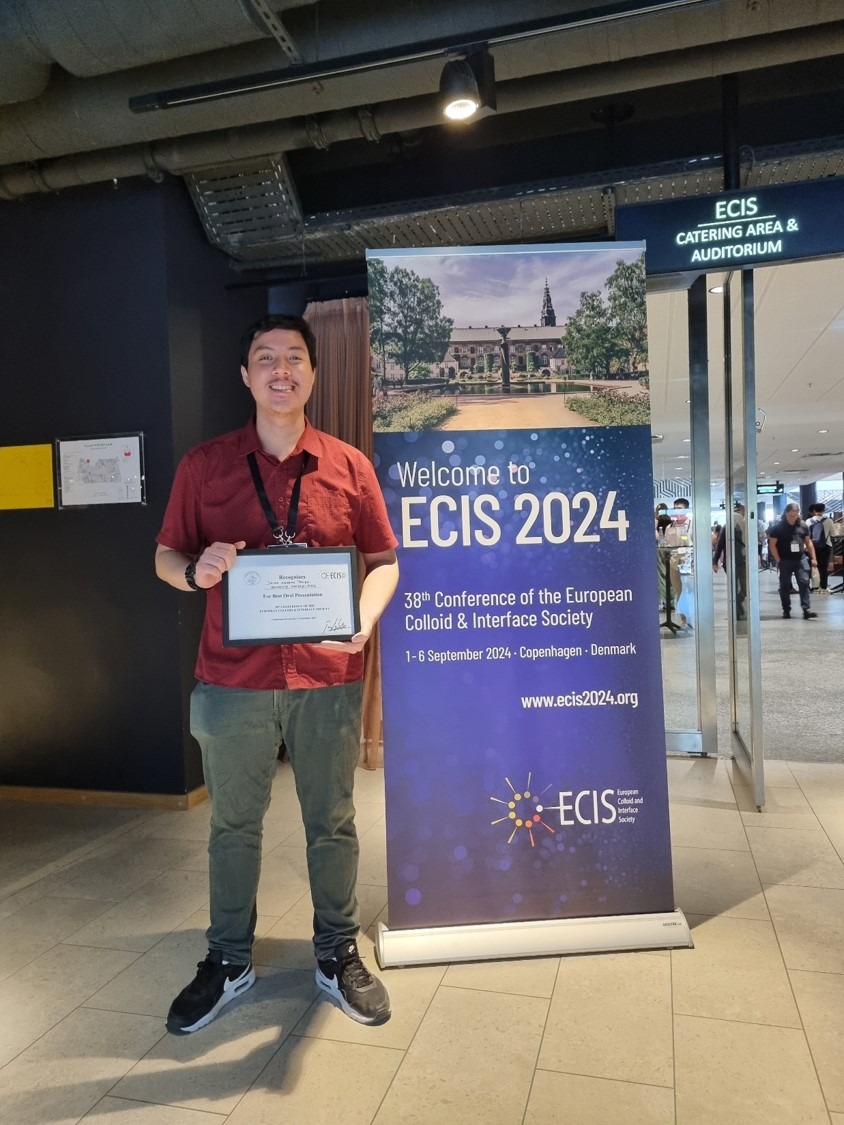 |
1-6 spetember 2024 Jaime won ECIS-Enzo Ferroni Award for Best Oral Presentation in the young researchers category at ECIS 2024 in Copenhagen. Congratz!
|
Telluride 2024
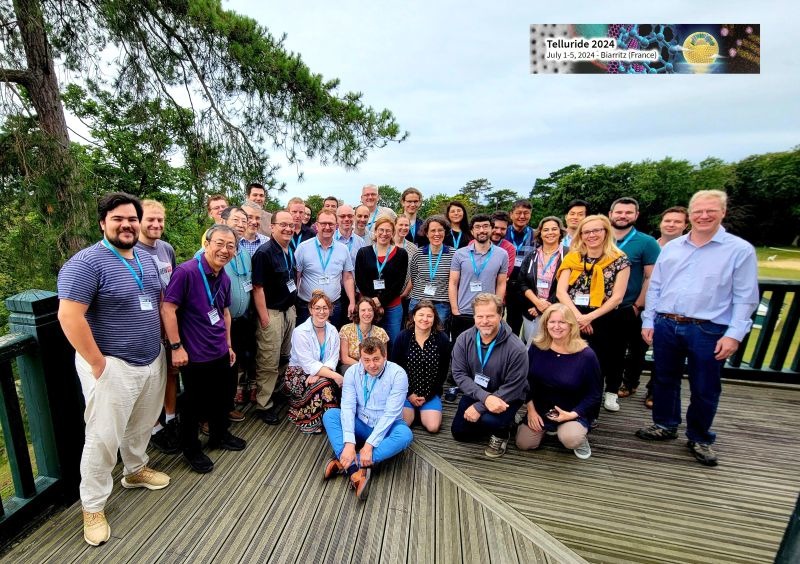 |
01-05/07/2024 I recently had the pleasure to attend to Telluride 2024 in Biarritz about solution-based nanoparticle synthesis and their application in devices. |
Young Distinguished Scholar Nanophotonic
The 25th of may, we were invited to join an online event organized by colleagues in China. The event was broadcasted on a streaming platform with more than 10000 simultaneous viewers! Cyrille received an award at this occasion. Thanks again for the invitation and the organization.
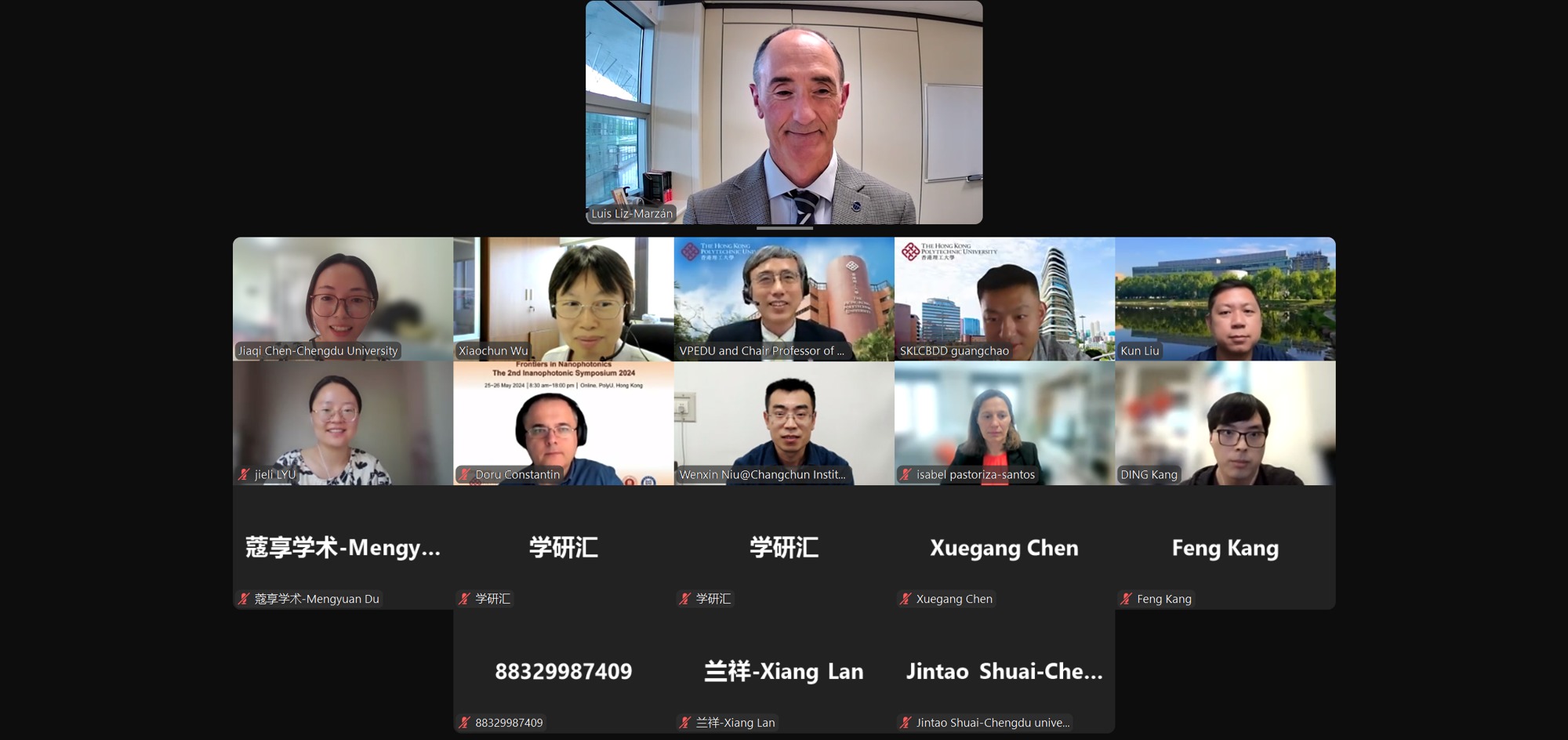
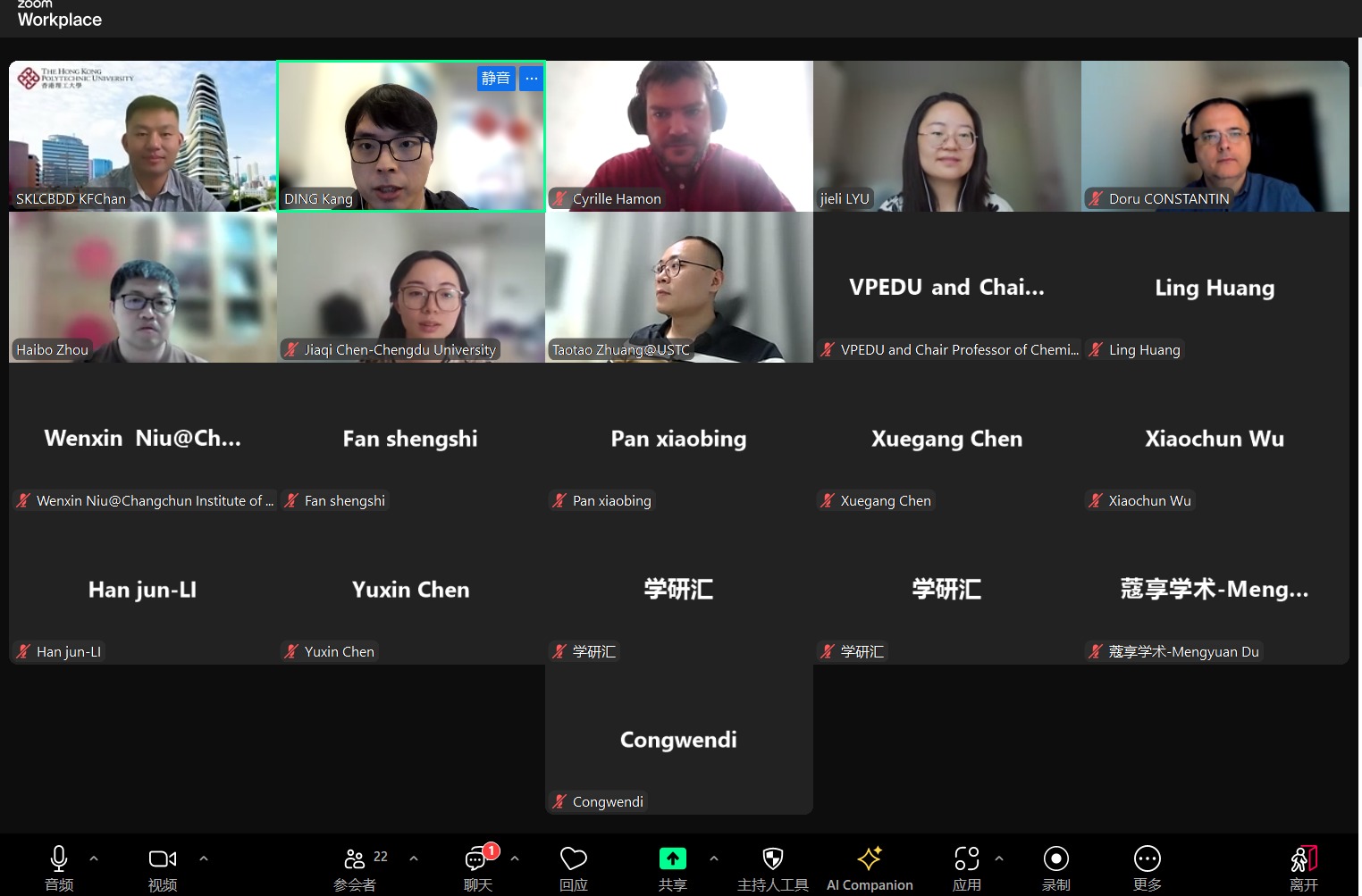

Recruitment of material scientists for CNRS position in 2024
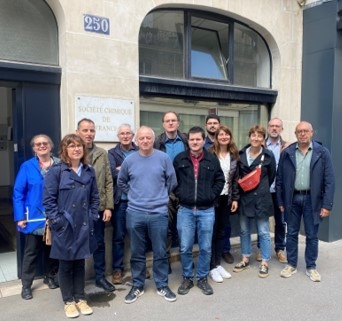 |
From the 14th of may to the 26th of may, we have listened to 60 presentations from researchers to recruit and promote CNRS scientists in 2024 (section 15). The auditions were in the 5th district at the headquarter of "Société Chimique de France". Thanks to SCF for hosting us during two weeks. The results for these sessions can be consulted there: https://sncs.fr/2024/03/05/concours-cnrs-2024/#S15 |
First barbecue of the year with the MATRIX team!
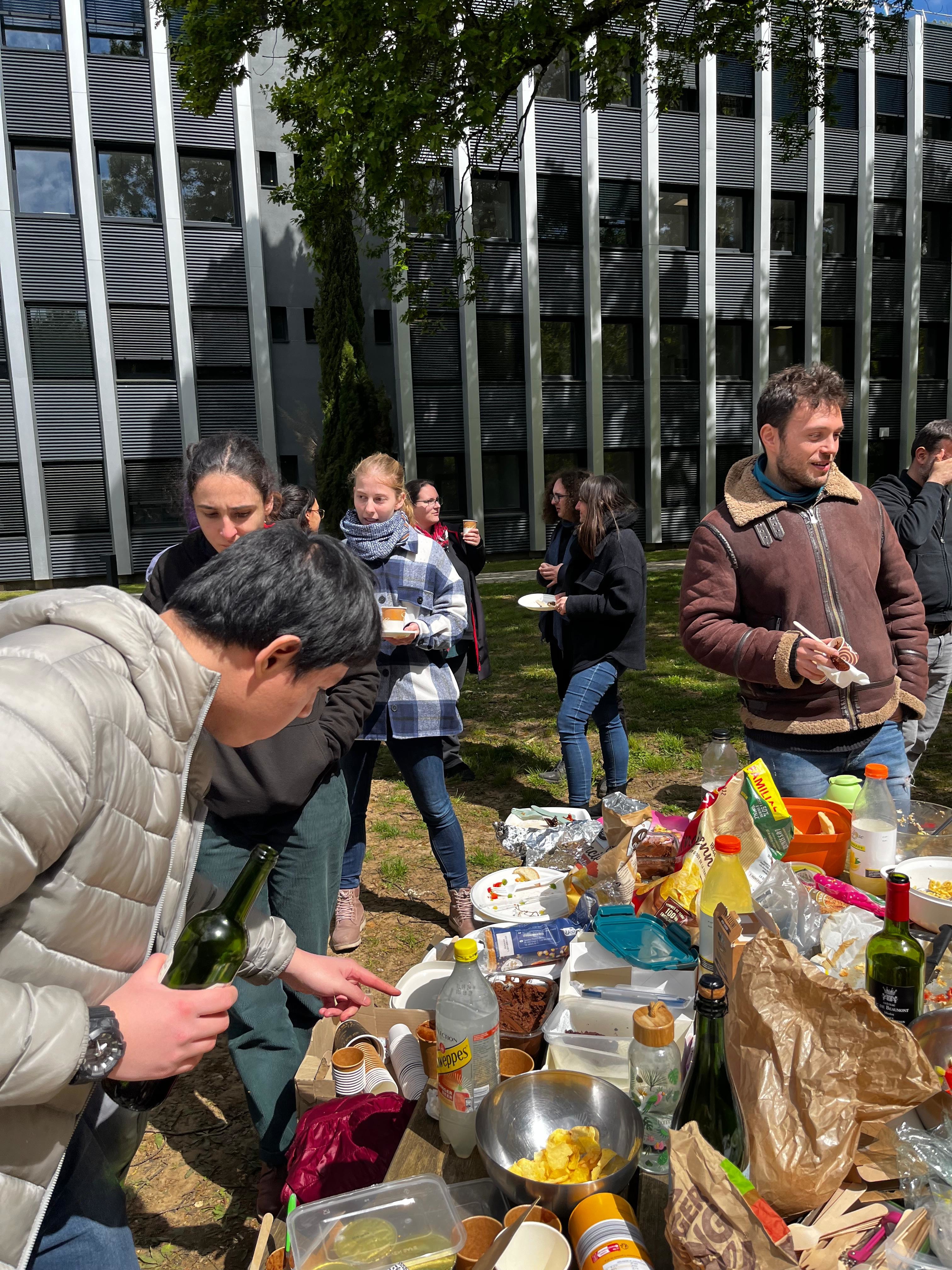 |
25/04/2024 |
Our latest paper was promoted by CNRS chimie
Our latest paper (DOI : 10.1021/acsnano.3c12799) on prismatic confinement was promoted by CNRS Chimie and LPS:
LPS: https://equipes2.lps.u-psud.fr/matrix/guiding-nanoparticle-assembly-into-complex-structures/
16/04/2024
Prismatic Confinement Induces Tunable Orientation in Plasmonic Supercrystals
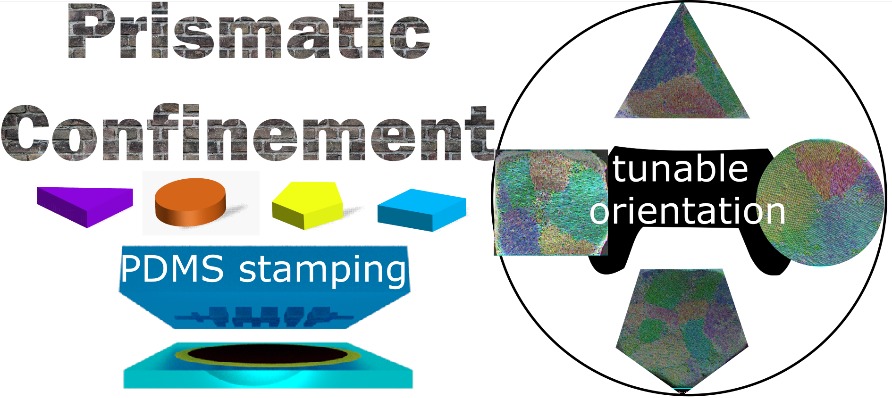 |
21/03/2024 Throughout history, scientists have looked to Nature for inspiration and attempted to replicate the intricate complex structures formed by self-assembly. In the context of synthetic supercrystals, achieving such complexity remains a challenge due to the highly symmetric nature of most nanoparticles (NPs). Previous works have shown intricate coupling between the self-assembly of NPs and confinement in templates such as emulsion droplets (spherical confinement) or tubes (cylindrical confinement). This study focuses on the interplay between anisotropic NP shape and tunable “prismatic confinement” leading to the self-assembly of supercrystals in cavities featuring polygonal cross-sections. A multiscale characterization strategy is employed to investigate the orientation and structure of the supercrystals, locally and at the ensemble level. Our findings highlight the role of the mold interface in guiding the growth of distinct crystal domains: each side of the mold directs the formation of a monodomain that extends until it encounters another, leading to the creation of grain boundaries. Computer simulations in smaller prismatic cavities were conducted to predict the effect of increased confinement. Comparison between prismatic confinement and cylindrical confinement shows that flat interfaces are key to orient the growth of supercrystals. This work shows a method of inducing orientation in plasmonic supercrystals and controlling their textural defects, thus offering insight into the design of functional metasurfaces and hierarchical structured devices. See article @ ACS Nano: DOI: 10.1021/acsnano.3c12799 |
Welcome Nika!
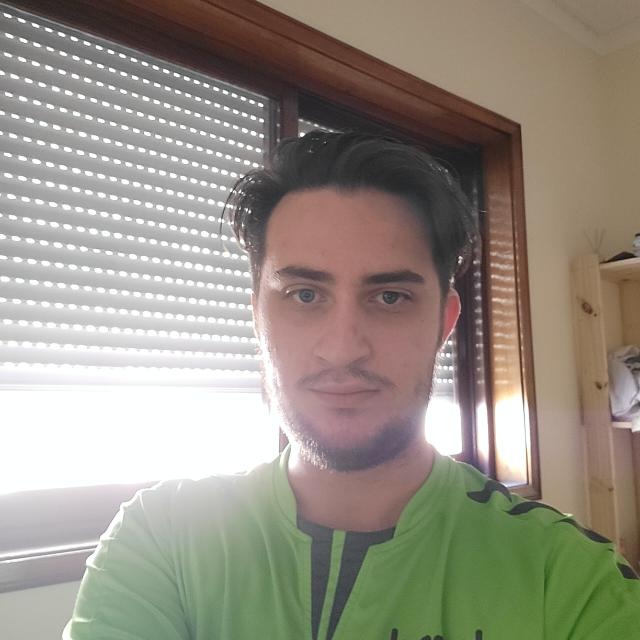 |
01/02/2024 I started thinking about chemistry when I participated in international chemistry Olympiad, (ICHO) 48 where I became fascinated about science. Therefore, I studied chemistry at San Diego State University Georgia and obtained bachelor’s degree there. Then, I decided to divert study direction towards physical chemistry and materials science that is why I applied to SERP master program at Université Paris-Saclay. Currently, I am involved in M2 internship in LPS where I work for the project “Templated Colloidal Crystals with Collective Optical or Magnetic Properties” which is supervised by Dr.Cyrille Hamon and Dr.Marianne Imperor-Clerc.
Currently, I am particularly interested in self-assembly of nanoparticles and how to utilize the properties of nanoparticles in the field of plasmonics/photonics and imaging.
|
Cyrille defended his HDR
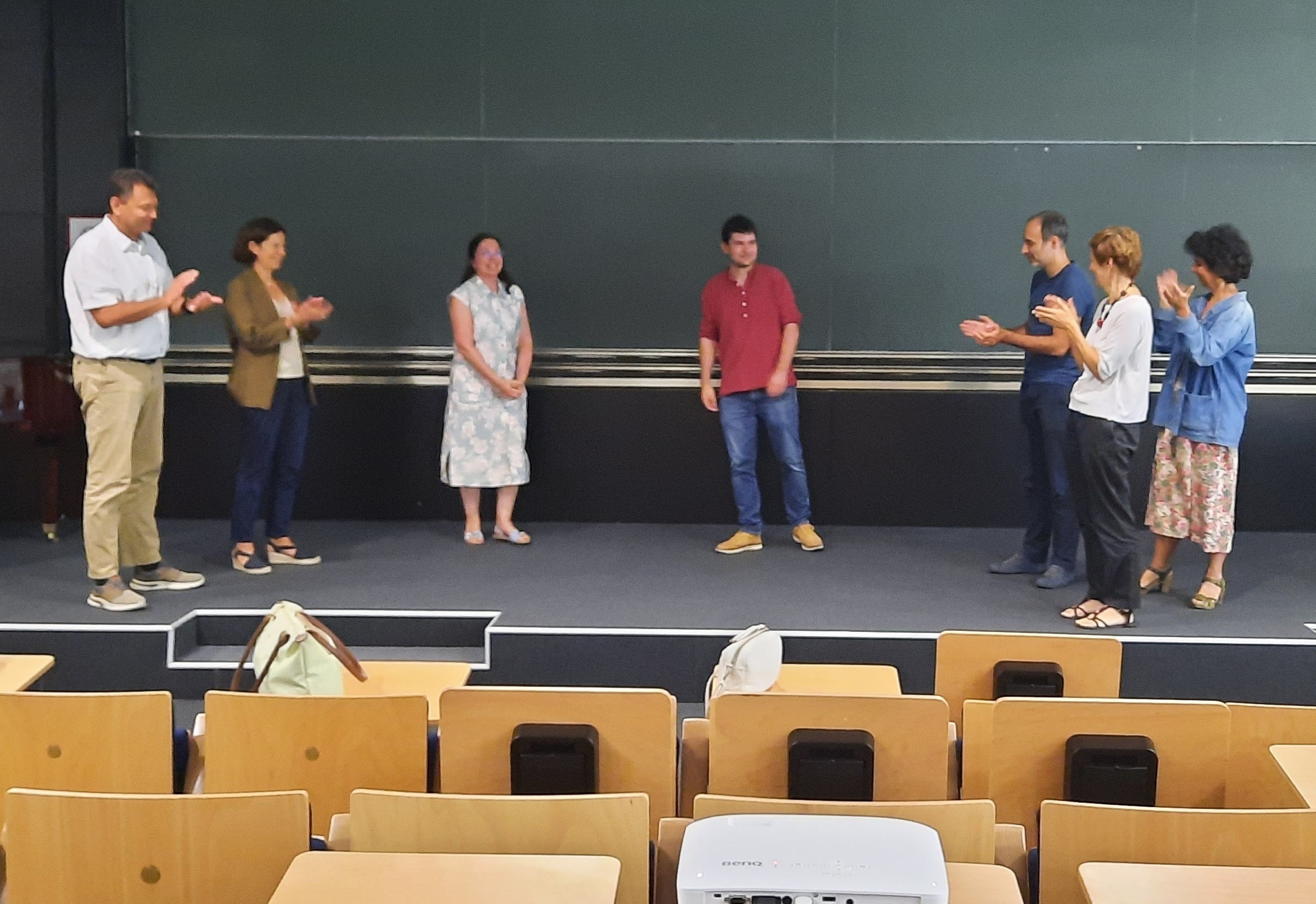 |
07/09/2023 Cyrille succesfully defended his accredidation to supervize research (HDR). Thanks to jury (from left to right): Stéphane Parola (ENS Lyon) Fabienne Testard (CEA Saclay) Hynd Remita (ICP) David Portehault (LCMCP) Mona Tréguer-Delapierre (ICMCB) Emmanuelle Lacaze (INSP) |
Congratulation to the new generation of researchers in the team (note 30/06/23)
Claire, Jules and Rahul got their abstract accepted for oral presentations in famous international conferences to come (NaNax in Austria and ECIS in Italy)
Claire Hotton won the best oral presentation at GFA in Mulhouse (21-23/06/2023)
Jaime Trazo presented well his past achievements and project in the team at ED2MIB doctoral competition and won a PhD grant (05/2023)
Jules Marcone won the best poster price at GDR NINO in Jussieu (14-16/02/2022)
Confinement Effects on the Structure of Entropy-InducedSupercrystals
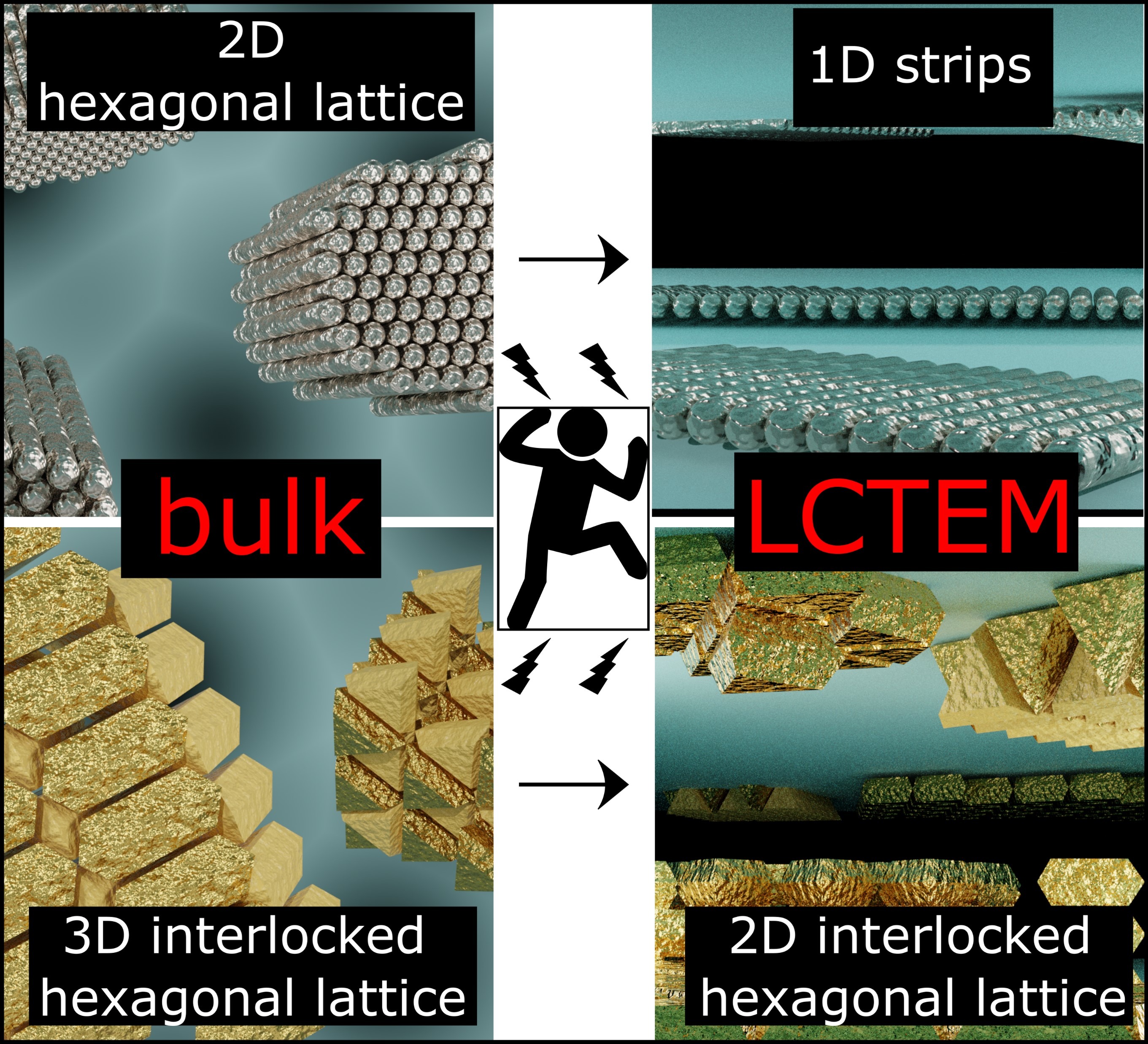 |
30/06/2023 Depletion-induced self-assembly is routinely used to separate plasmonicnanoparticles (NPs) of different shapes, but less often for its ability to createsupercrystals (SCs) in suspension. Therefore, these plasmonic assemblieshave not yet reached a high level of maturity and their in-depthcharacterization by a combination of in situ techniques is still very muchneeded. In this work, gold triangles (AuNTs) and silver nanorods (AgNRs) areassembled by depletion-induced self-assembly. Small Angle X-ray Scattering(SAXS) and scanning electron microscopy (SEM) analysis shows that theAuNTs and AgNRs form 3D and 2D hexagonal lattices in bulk, respectively.The colloidal crystals are also imaged by in situ Liquid-Cell TransmissionElectron Microscopy. Under confinement, the affinity of the NPs for the liquidcell windows reduces their ability to stack perpendicularly to the membraneand lead to SCs with a lower dimensionality than their bulk counterparts.Moreover, extended beam irradiation leads to disassembly of the lattices,which is well described by a model accounting for the desorption kineticshighlighting the key role of the NP-membrane interaction in the structuralproperties of SCs in the liquid-cell. The results shed light on thereconfigurability of NP superlattices obtained by depletion-inducedself-assembly, which can rearrange under confinement. Article open access: https://doi.org/10.1002/smll.202303380 |
Polymorphous packing of pentagonal nanoprisms
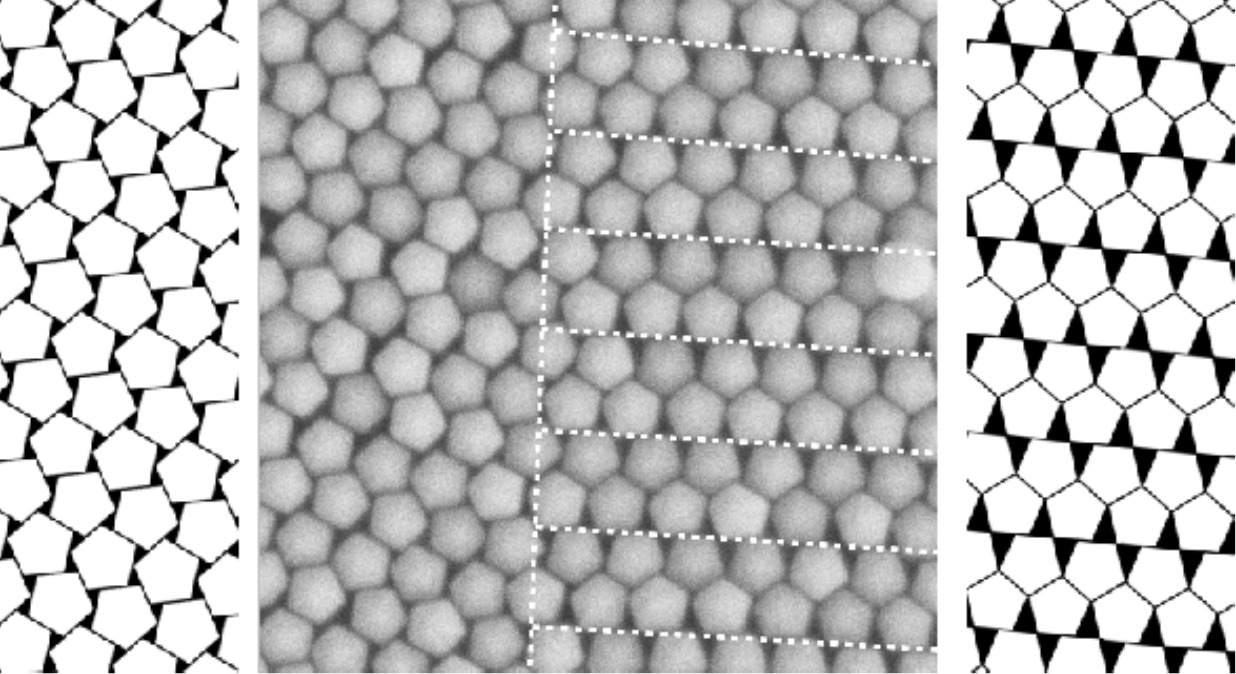 |
11/02/2023 Packing solid shapes into regular lattices can yield very complex assemblies, not all of which achieve the highest packing fraction. In two dimensions, the regular pentagon is paradigmatic, being the simplest shape that does not pave the plane completely. In this work, we demonstrate the packing of plasmonic nanoprisms with pentagonal cross section, which form extended supercrystals. We do encounter the long-predicted ice-ray and Durer packings (with packing fractions of 0.921 and 0.854, respectively), but also a variety of novel polymorphs that can be obtained from these two configurations by a continuous sliding transformation and exhibit an intermediate packing fraction. Beyond the fundamental interest of this result, fine control over the density and symmetry of such plasmonic assemblies opens the perspective of tuning their optical properties, with potential applications in metamaterial fabrication, catalysis or molecular detection. |
Welcome Jaime!
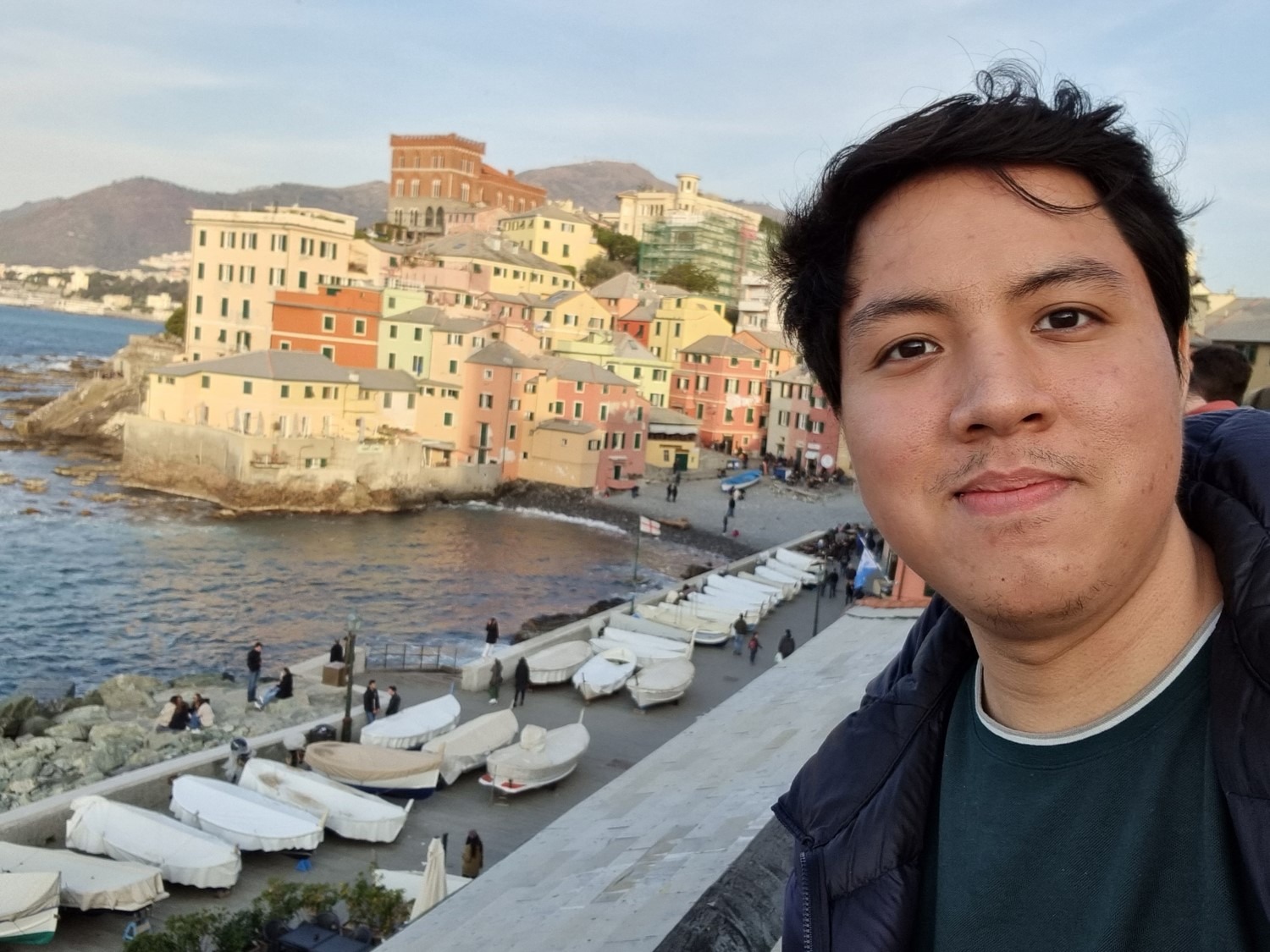 |
03/02/2023
Jaime Gabriel Trazo earned his bachelor degrees in Chemistry and in Materials Science and Engineering at the Ateneo de Manila University (2019, 2020), where he worked on formulating green silver nanoparticle inks for printed electronics and on nanocellulose synthesis, under Dr. Jose Mario Diaz and Dr. Erwin Enriquez. He was also a National Awardee at the BPI-DOST Science Awards 2019 in the Philippines.
He is now pursuing his master’s degree under the Erasmus Mundus SERP+ Program. For his M2 internship, he joined the Laboratoire de Physique des Solides, where he works on the self-assembly of nanoparticles into supercrystals with collective optical/magnetic properties, under Dr. Cyrille Hamon and Dr. Marianne Impéror-Clerc. His current research interests and experience are in the intersection of chemistry and nanomaterials, particularly for plasmonics, electronics, opto-electronics, and energy applications. |
Welcome Rahul!
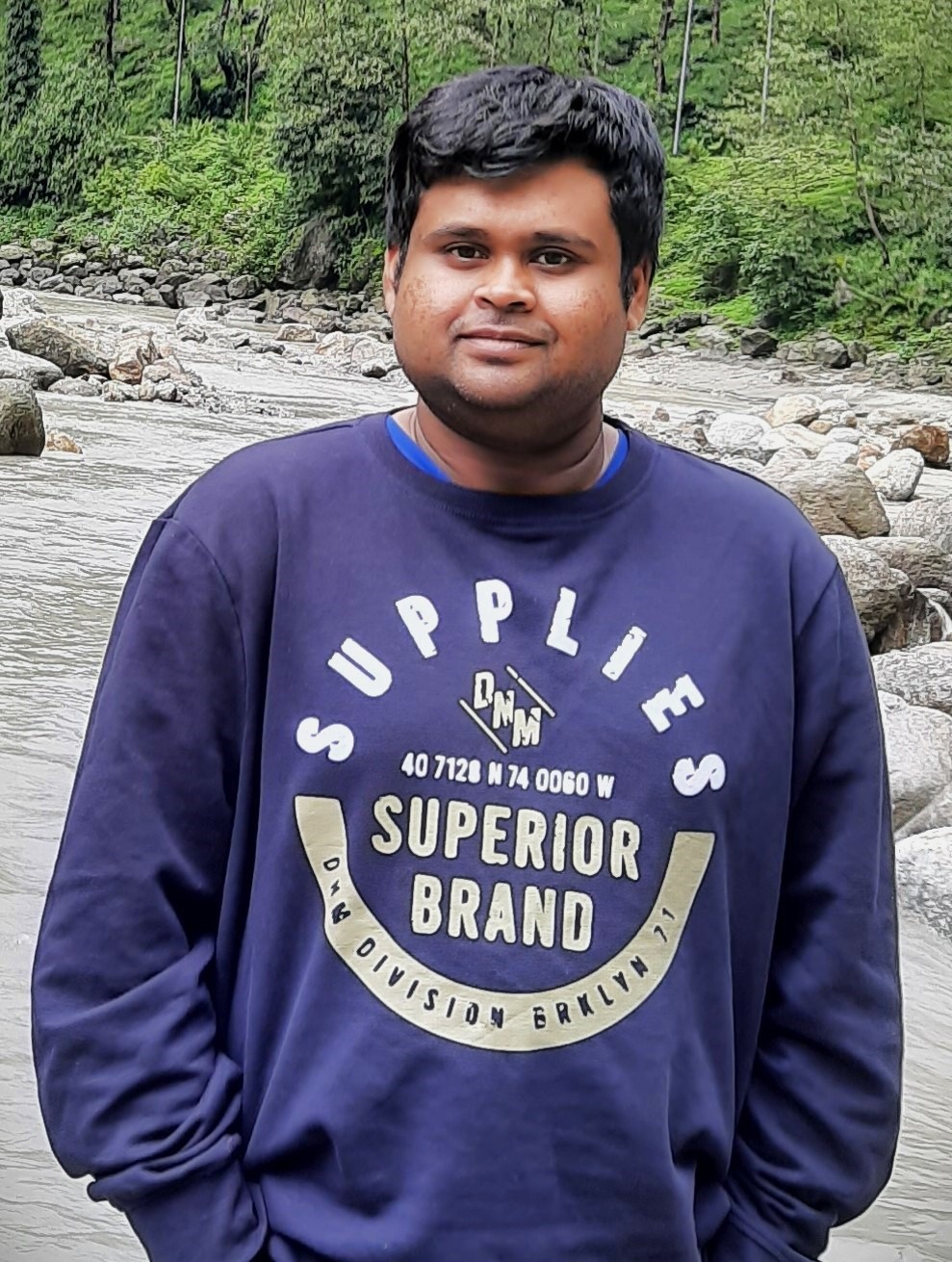 |
02-02-2023 Rahul Nag obtained his PhD from IIT Bombay under the supervision of Chebrolu Pulla Rao in Bio-Inorganic Chemistry Laboratory. He worked on the surface functionalization of nanostructures by organic conjugates specially calixarenes which involved applications in sensing, cancer cell killing, catalysis. He did a one-year post-doctoral research in CBMN/University of Bordeaux under the supervision of Emilie Pouget in the Chiral Molecular Assemblies Group led by Reiko Oda. He is now joining the Laboratoire of Physique des Solides as a postdoctoral researcher with Cyrille Hamon. Currently, his interest focuses on the synthesis of gold nanostructures controlling their shapes and sizes for possible application in non-linear optics. |
Extracting the morphology of gold bipyramids from small-angle X-ray scattering experiments via form
|
|
25/01/2023 Accurate shape description is a challenge in materials science. Small-angle X-ray scattering (SAXS) can provide the shape, size and polydispersity of nanoparticles by form factor modelling. However, simple geometric models such as the ellipsoid may not be enough to describe objects with complex shapes. This work shows that the form factor of gold nanobipyramids is accurately described by a truncated bicone model, which is validated by comparison with transmission electron microscopy (TEM) data for nine different synthesis batches; the average shape parameters (width, height and truncation) and the sample polydispersity are obtained. In contrast, the ellipsoid model yields worse fits of the SAXS data and exhibits systematic discrepancies with the TEM results. |
Happy 2023!
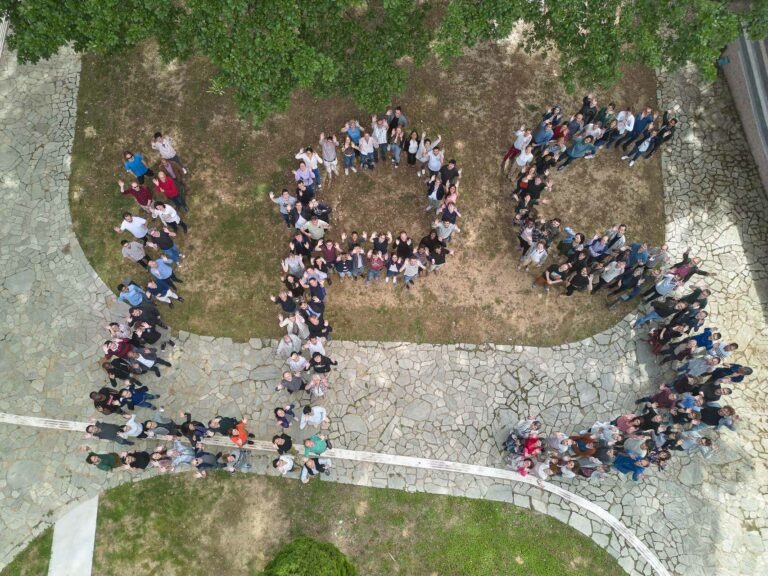
Welcome Jules and Claire!
Jules joined in october as a PhD student and Claire joined in december as a post-doc. Welcome!
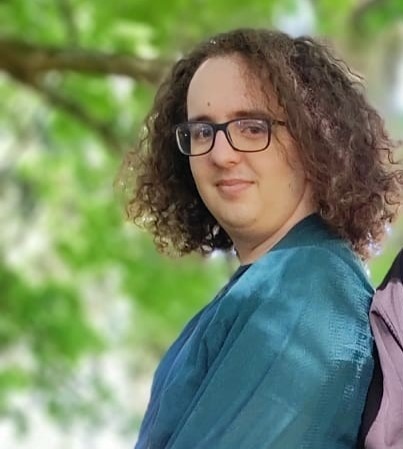 |
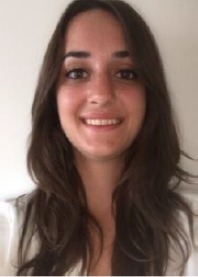 |
21/12/2022
Formation of kinetically trapped small clusters of PEGylated gold nanoparticles revealed by the comb
 |
26/10/2022. Gold nanoparticles coated with polyethylene glycol (PEG) are able to form clusters due to the collapse of the surface-grafted polymer chains when the temperature and ion concentration of the aqueous medium are increased. The chain collapse reduces the steric repulsion, leading to particle aggregation. In this work, we combine small angle X-ray scattering (SAXS) and visible light spectroscopy to elucidate the structure of the developing clusters. The structure derived from the SAXS measurements reveals a decrease in interparticle distance and drastic narrowing of its distribution in the cluster, indicating restricted particle mobility and displacement within the cluster. Surprisingly, instead of forming a large crystalline phase, the evolving clusters are composed of about a dozen particles. The experimental optical extinction spectra measured during cluster formation can be very well reproduced by optical simulations based on the SAXS-derived structural data.
Thanks to Daniel and Andras from the Centre for Energy Research (Budapest, Hungary) for this nice collaboration. |
Longitudinal and Transversal Directed Overgrowth of Pentatwinned Silver Nanorods with Tunable Optica
|
|
07/07/2022 Silver nanorods (AgNRs) with a controllable aspect ratio can be formed by templated growth from pentatwinned seeds. However, it is challenging to control the volume of the AgNRs and their aspect ratio independently because of the selective protection against growth of the lateral facets by halides. Here we demonstrate the preparation of AgNRs with tunable width via the addition of dimethyl sulfoxide (DMSO). AgNRs with custom dimensions were produced by separating the longitudinal and transverse growth in a two-step procedure. In the first step, the length is tuned by directing the overgrowth on the {111} tips of the AgNRs. In the second step, the width is adjusted by directing the overgrowth on the {100} lateral facets in the presence of DMSO. AgNRs of varying dimensions were obtained and characterized by a combination of techniques including scanning transmission electron microscopy, electron energy loss spectroscopy, and cathodoluminescence, which are, respectively, sensitive to the extinction and scattering component of the AgNRs’ response. This method allows tuning the plasmon energies, but also the ratio of the scattering and absorption contributions. |
Jieli presented her PhD
|
05/07/2022 Jieli Lyu successfully presented her PhD after 4 years in the lab under the supervision of Doru, Cyrille and Marianne. It was pointed out that she arrived as a young student and will leave the lab as a young scientist. Congratulation Jieli! |
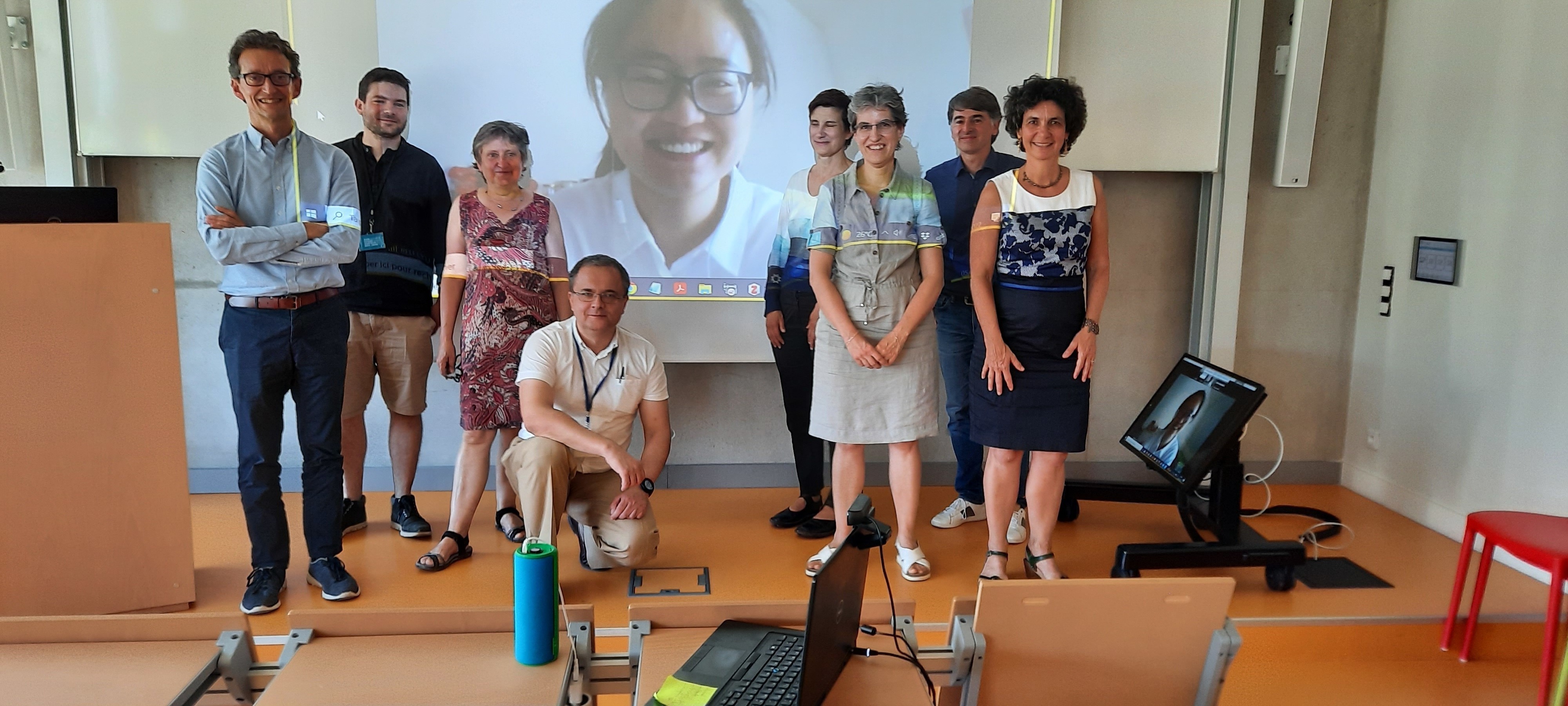 |
Shape-Controlled Second-Harmonic Scattering from Gold Nanotetrapods
 |
02/06/2022 In the search for efficient building blocks for nonlinear metamaterials, plasmonic nanoparticles have received considerable attention. Their quadratic nonlinear optical properties result from a complex interplay between the nature of the bulk material, the object shape, surface defects, and retardation effects. This versatility can be used to tailor the properties of the resulting material. However, despite extensive investigation, separating and controlling these contributions still pose a challenge. In this report, we control the morphology of colloidal gold nanoparticles with tetrahedral symmetry and explore their second harmonic scattering response. The material itself is centrosymmetric but not the shape, conferring to the first hyperpolarizability an almost purely octupolar symmetry. Gradually reshaping the nanoparticles into spheres (and thus decreasing their asymmetry) reduces their nonlinear response, showing that it is controlled by the morphology. These results open the way toward new kinds of nonlinear plasmonics platforms and imaging probes. |
Acoustic Vibration Modes of Gold–Silver Core–Shell Nanoparticles
 |
30/05/2022 Bimetallic Au/Ag core–shell cuboid nanoparticles (NPs) exhibit a complex plasmonic response dominated by a dipolar longitudinal mode and higher-order transverse modes in the near-UV, which may be exploited for a range of applications. In this paper, we take advantage of the strong signature of these modes in the NP ultrafast transient optical response, measured by pump-probe transient absorption (TA) spectroscopy, to explore the NP vibrational landscape. The fast Fourier transform analysis of the TA dynamics reveals specific vibration modes in the frequency range 15–150 GHz, further studied by numerical simulations based on the finite element method. While bare Au nanorods exhibit extensional and breathing modes, the bimetallic NPs undergo more complex motions, involving the displacement of facets, edges and corners. The amplitude and frequency of these modes are shown to depend on the Ag shell thickness, as the silver load modifies the NP aspect ratio and mass. Moreover, the contributions of the vibrational modes to the experimental TA spectra are shown to vary with the probe laser wavelength at which the signal is monitored. Using the combined simulations of the NP elastic and optical properties, we elucidate this influence by analyzing the effect of the mechanisms involved in the acousto-plasmonic coupling. Thanks to the collaborators for this nice work. https://doi.org/10.3390/chemosensors10050193 |
Laser-Driven Bubble Printing of Plasmonic Nanoparticle Assemblies onto Nonplasmonic Substrates
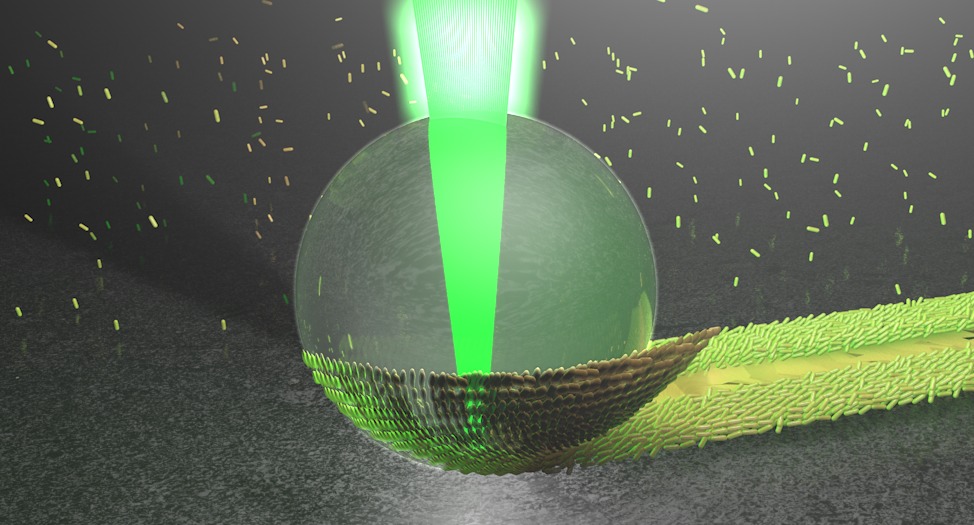 |
28/04/2022 The use of optically controlled vapor bubbles for controlled synthesis and deposition at interfaces is a promising emerging technique, which is intrinsically limited by the ability of the system to provide enough heat for bubble formation that is typically addressed using a plasmonic substrate. Herein, a simple and fast method for laser-controlled printing of plasmonic nanoparticles onto nonplasmonic substrates is shown. The laser fluence needed to print the nanoparticle was lowest for nanoparticles in resonance with the laser wavelength, but the technique is also effective off-resonance. Hierarchical assemblies were obtained, where melting was observed up to a micron from the focal point of the laser beam. The assemblies show plasmonic properties in the unmelted region, as shown by surface-enhanced Raman scattering spectroscopy measurements. This work will lead to future studies on controlling the hierarchical structure of nanoparticle assemblies formed at the bubble interface toward applications in sensing and devices. https://doi.org/10.1021/acs.jpcc.2c02414 Thanks to Eric Hill and his nice microscope for printing plasmonic patterns. |
Double-lattice packing of pentagonal gold bipyramids in supercrystals with triclinic symmetry
24/03/2022
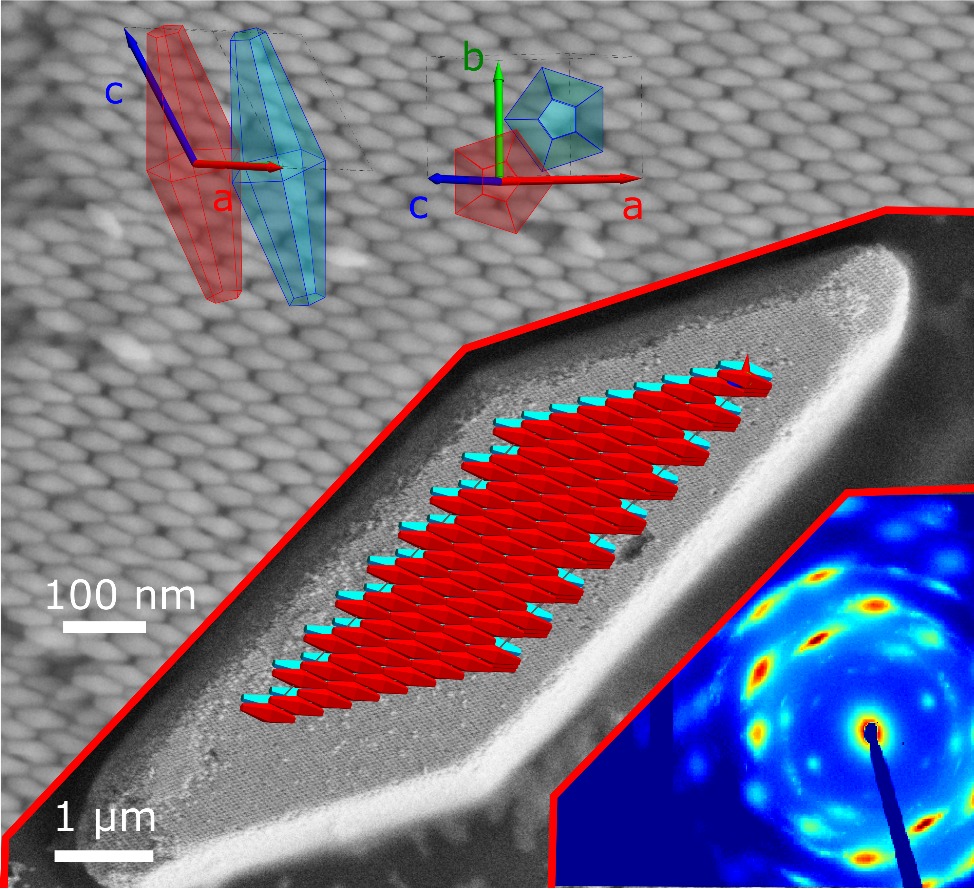 |
Pentagonal packing is a long-standing issue and a rich mathematical topic, brought to the fore by recent progress in nanoparticle design. Gold pentagonal bipyramids combine five-fold symmetry and anisotropy and their section varies along the length. In this work, we obtain colloidal supercrystals of pentagonal gold bipyramids in a compact arrangement that generalizes the optimal packing of regular pentagons in the plane. Multimodal investigations reveal a two-particle unit cell with triclinic symmetry, a lower symmetry than that of the building blocks. Monte Carlo computer simulations show that this lattice achieves the densest possible packing. Going beyond pentagons, further simulations show an odd-even effect of the number of sides on the packing: odd-sided bipyramids are non-centrosymmetric and require the double-lattice arrangement to recover inversion symmetry. The supercrystals display a facet-dependent optical response that is promising for sensing, metamaterials applications and for fundamental studies of self-assembly processes. Press release: CNRS: https://www.inp.cnrs.fr/fr/cnrsinfo/lart-dempiler-des-pyramides |
Welcome Jianan!
28/01/2021
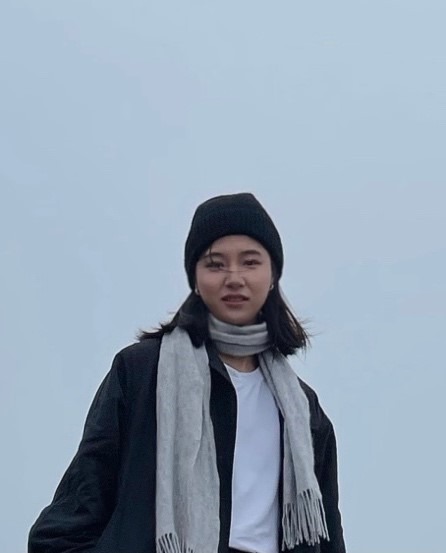 |
I obtained my Bachelor of Engineering in Nano Materials and Technology from Soochow University in China. During my undergraduate study, I worked on several projects related to nanoscaled functional materials for energy conversion and storage under the supervision of Prof. Yanguang Li.
I am now the M2 student from Erasmus Mundus Joint Master program: SERP+. Currently, I am working on my thesis project about self-assembly of colloidal liquid crystal in levitation under the supervision of Dr. Cyrille Hamon and Dr. Erwan Paineau. |
Happy 2022!
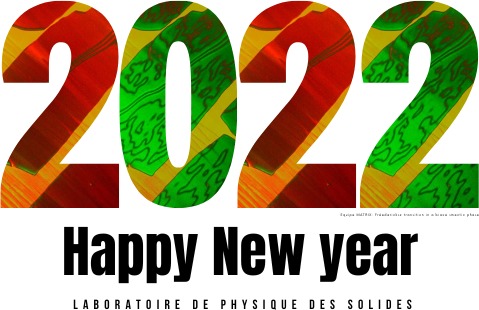
credit photo MATRIX team: Fréedericksz transition in a biaxe smectic phase
Unveiling the Coupling of Single Metallic Nanoparticles to Whispering-Gallery Microcavities
16/12/2021
 |
Nice work published in collaboration with the STEM group @ LPS
10.1021/acs.nanolett.1c03826 Whispering-gallery mode resonators host multiple trapped narrow-band circulating optical resonances that find applications in quantum electrodynamics, optomechanics, and sensing. However, the spherical symmetry and low field leakage of dielectric microspheres make it difficult to probe their high-quality optical modes using far-field radiation. Even so, local field enhancement from metallic nanoparticles (MNPs) coupled to the resonators can interface the optical far field and the bounded cavity modes. In this work, we study the interaction between whispering-gallery modes and MNP surface plasmons with nanometric spatial resolution by using electron-beam spectroscopy with a scanning transmission electron microscope. We show that gallery modes are induced over a selective spectral range of the nanoparticle plasmons, and additionally, their polarization can be controlled by the induced dipole moment of the MNP. Our study demonstrates a viable mechanism to effectively excite high-quality-factor whispering-gallery modes and holds potential for applications in optical sensing and light manipulation. Thanks to the STEM group @ LPS and especially to Yves Auad whom carried out the experiments. |
Gold-clay nanocomposite colloids with liquid-crystalline and plasmonic properties
14/09/2021
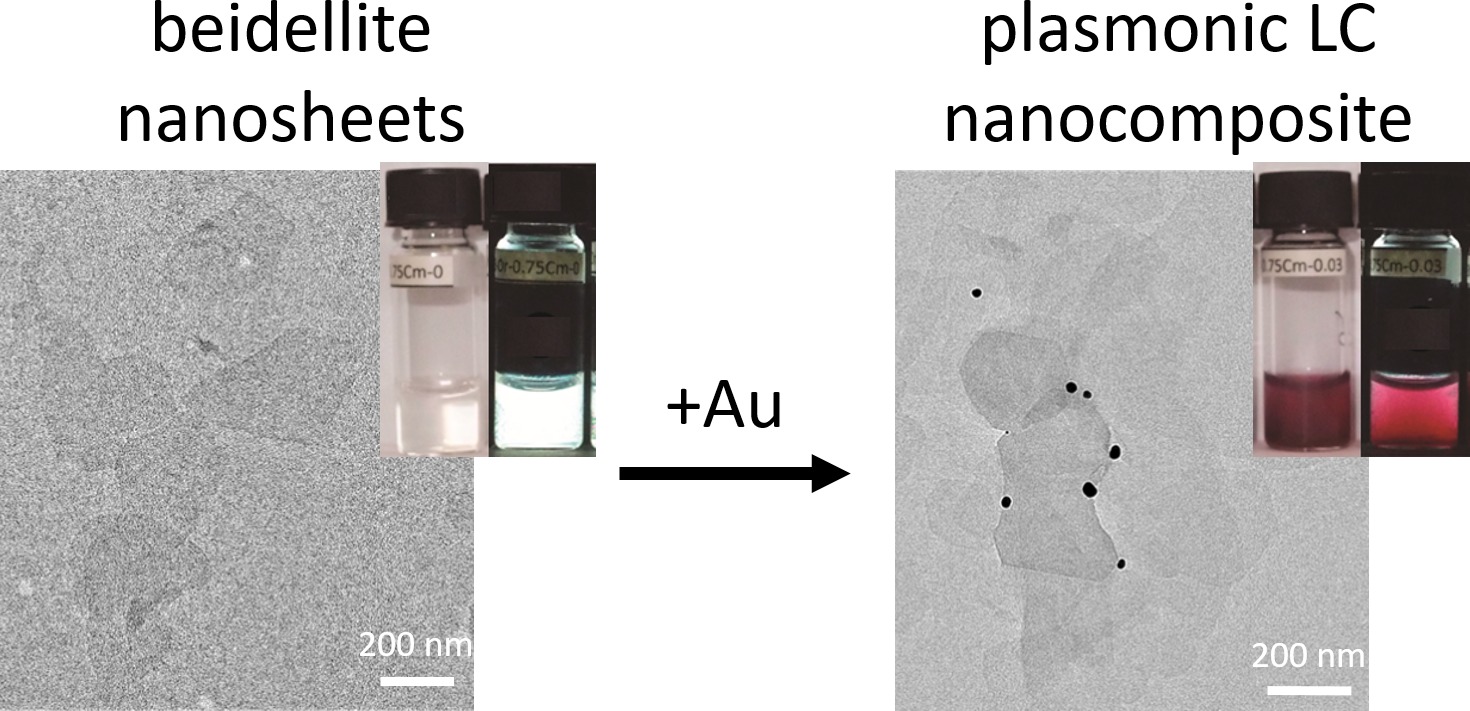 |
Imparting liquid-crystal (LC) materials with the plasmonic properties of metal nanoparticles is actively pursued for applications. We achieved this goal by synthetizing gold nanoparticles onto clay nanosheets, leading to nematic nanocomposite suspensions. Optical observations and structural analysis show the growth of the gold nanoparticles without altering the LC properties of the nanosheets. These colloids display plasmonic structural colours and they can be aligned by an electric field, which is relevant for fundamental and materials chemistry of colloidal LC. |
Doping Liquid Crystals of Colloidal Inorganic Nanotubes by Additive-Free Metal Nanoparticles
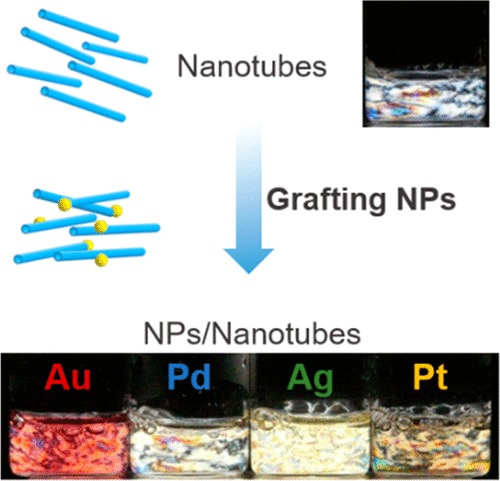 |
25/05/2021 https://doi.org/10.1021/acs.jpclett.1c01311 Doping liquid-crystal phases with nanoparticles is a fast-growing field with potential breakthroughs due to the combination of the properties brought by the two components. One of the main challenges remains the long-term stability of the hybrid system, requiring complex functionalization of the nanoparticles at the expense of their self-assembly properties. Here we demonstrate the successful synthesis of additive-free noble-metal nanoparticles at the surface of charged inorganic nanotubes. Transmission electron microscopy and UV-visible spectroscopy confirm the stabilization of metallic nanoparticles on nanotubes. Meanwhile, the spontaneous formation of liquid-crystals phases induced by the nanotubes is observed, even after surface modification with metallic nanoparticles. Small-angle X-ray scattering experiments reveal that the average interparticle distance in the resulting hybrids can be easily modulated by controlling electrostatic interactions. As a proof-of-concept, we demonstrate the effectiveness of our method for the preparation of homogeneous transparent hybrid films with a high degree of alignment. |
Symmetry breaking in seed-mediated silver nanorod growth induced by dimethyl sulfoxide
12/04/2021
https://doi.org/10.1021/acs.chemmater.1c00454
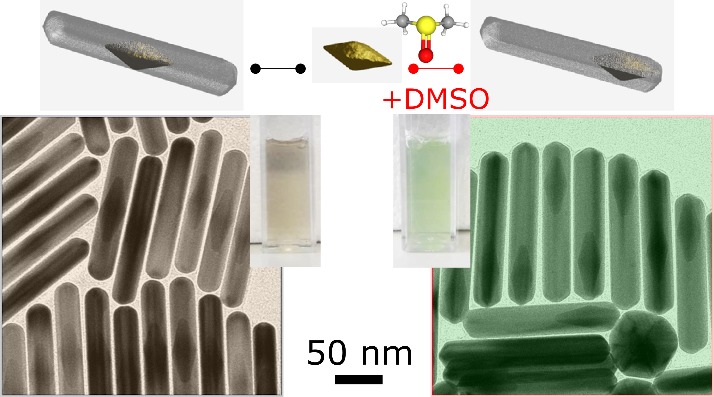 |
|
Engineering symmetry breaking in seed-mediated growth is a fundamental challenge to produce colloidal nanocrystals with controlled morphologies and properties. In this work, we show a simple, aqueous approach to breaking the inversion symmetry of silver nanorods by restricting growth to one end of the pentatwinned gold bipyramid seed. Controlled addition of dimethyl sulfoxide (DMSO) allows us to tune both the symmetry and the length and width of the objects. Simulations and experiments demonstrate the adsorption of DMSO, which displaces interfacial water, reduces binding of surfactant and chloride ions at the gold surface, and slows down the deposition kinetics of silver. Besides showing the potential of DMSO for controlling the synthesis of complex nanostructures, this work opens new perspectives for the study of the physical properties of non-centrosymmetric nanoparticles, e.g. by controlling their plasmon modes and their second-harmonic generation efficiency. |
Structure and Formation Kinetics of Millimeter-Size Single Domain Supercrystals
31/03/2021
https://doi.org/10.1002/adfm.202101869
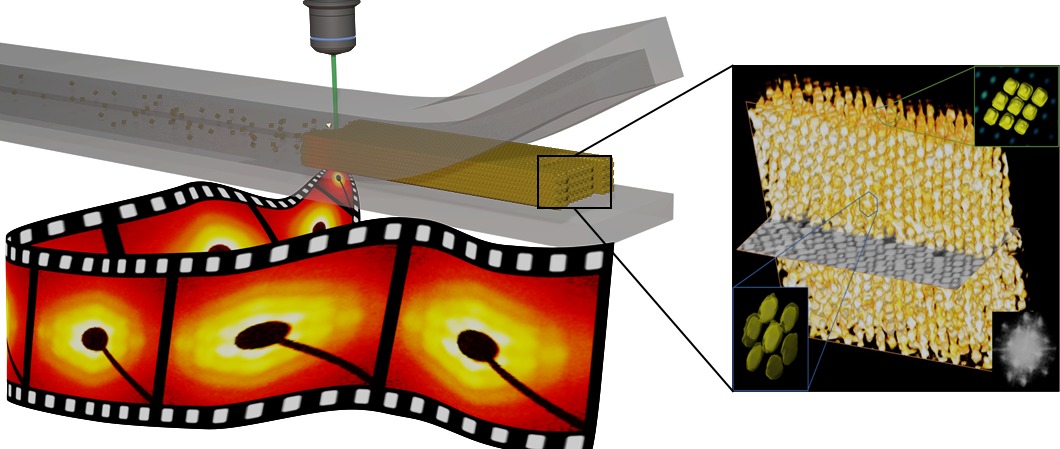 |
Organizing nanoparticles (NPs) into periodic structures is a central goal in materials science. Despite progress in the last decades, it is still challenging to produce macroscopic assemblies reliably. In this work, we report the analysis of the pervaporation-induced organization of gold octahedra into supercrystals within microfluidic channels using a combination of X-ray scattering techniques and FIB-SEM tomography. The results reveal the formation of a single-domain supercrystal with a monoclinic C2/m symmetry and long-range order extending over the dimensions of the microfluidic channel, covering at least 1.7x0.3 mm2. Time-resolved small angle X-ray scattering analysis showed that the formation of the superlattice involves an accumulation of the NPs within the channel before the nucleation and growth of the supercrystal. The orientation of the crystal remains unchanged during its formation, suggesting a growth mechanism directed by the channel interface. Together, these results show the potential application of the pervaporation strategy to providing spatially determined control over NP crystallization, which can be used for the rational fabrication of nanomaterial architectures.
Sharp Spectral Variations of the Ultrafast Transient Light Extinction by Bimetallic Nanoparticles in
|
11/02/2021
|
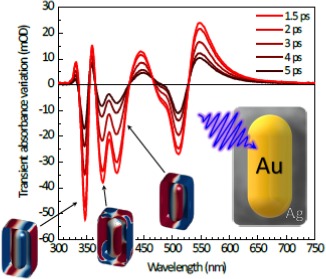 |
Welcome Samantha!
27/01/2021
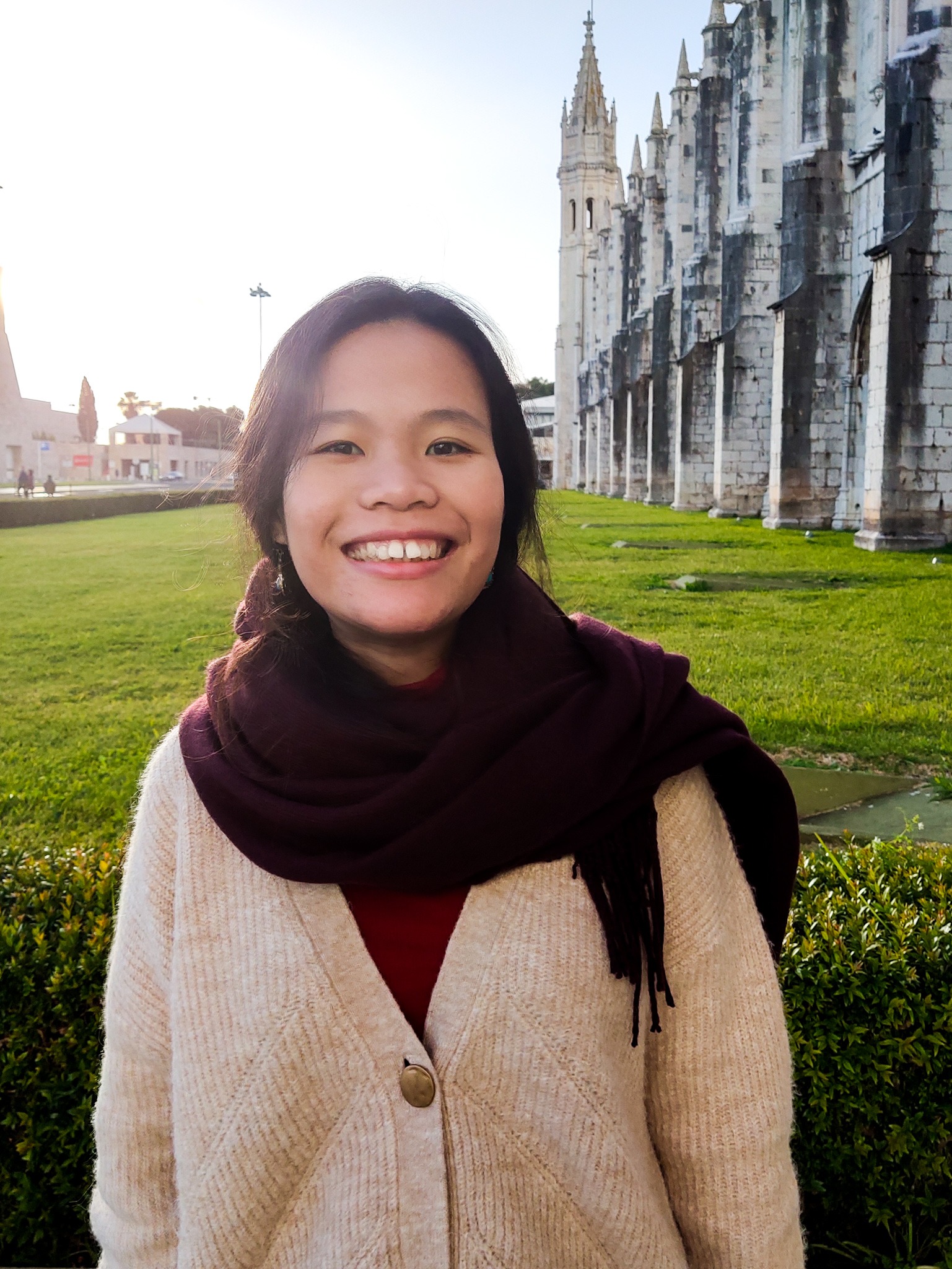 |
|
Two-step assembly kinetics of gold nanoparticles
06/01/2021
DOI: https://doi.org/10.1039/D0TC05076H
|
|
Abstract: We study the assembly kinetics of surfactant-stabilized gold nanoparticles in the presence of sulfate ions. The reaction proceeds in two steps: very rapid (a few minutes) formation of amorphous aggregates, followed by slow reordering (over several hours). The latter process is the only one detectable via absorbance spectroscopy and results in the formation of intimate contacts between the objects, with interparticle distances below the thickness of a surfactant bilayer. The rate-limiting step of the reaction could be related to surfactant expulsion from the initial aggregates, which allows the particles to come in close contact and form chains. There are marked differences in reaction yield and rate constant between spheres, rods and bipyramids, highlighting the role of surface curvature in contact formation. Once formed, the assemblies are very sturdy and stable under centrifugation and dialysis. The contact interaction is strong and highly directional, as shown by liquid-cell transmission electron microscopy. |
Happy new year!
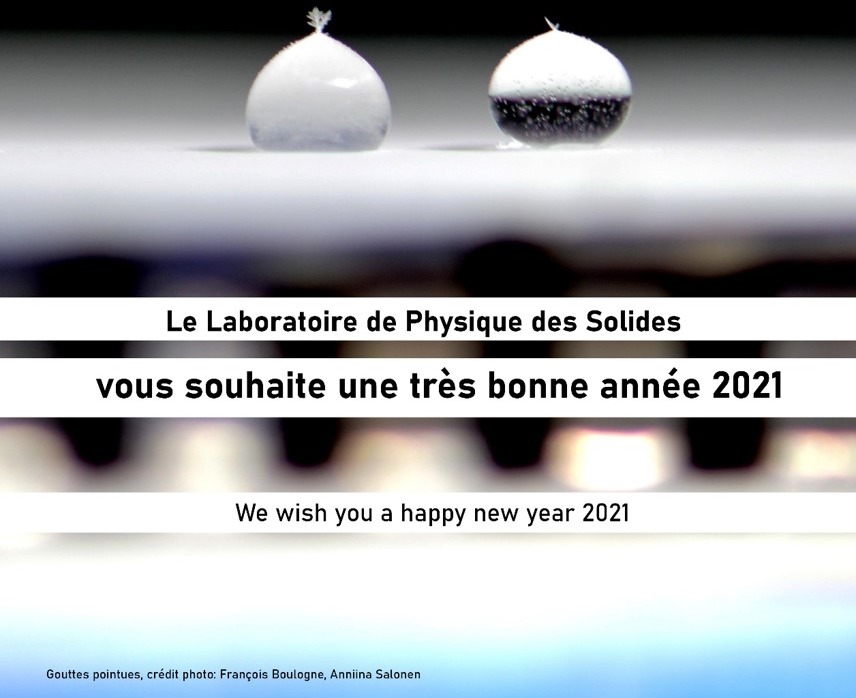
Two papers accepted on bimetallic NPs synthesis
2020-09-09
|
Growth kinetics of core-shell Au/Ag nanoparticles
|
Welcome Wajdi!
2020-09-09
Wajdi is a new postdoctoral researcher in the team MATRIX. His interest focuses on self-assembling plasmonic nanoparticles in confinement. The nanostructuration will be resolved at the single supercrystal level using an innovative Small Angle X-ray Scattering (SAXS) setup developed on a synchrotron beamline (SWING, @SOLEIL).
Real-Time In Situ Observations Reveal a Double Role for Ascorbic Acid in the Anisotropic Growth of S
25/03/2020
Our article have been published in J. Phys. Chem. Lett. Those results have been obtained during the M2 internship of Kinanti Aliyah. It is a collaborative work with the SOLEIL Synchrotron and MPQ lab (Université de Paris).
DOI: acs.jpclett.0c00121
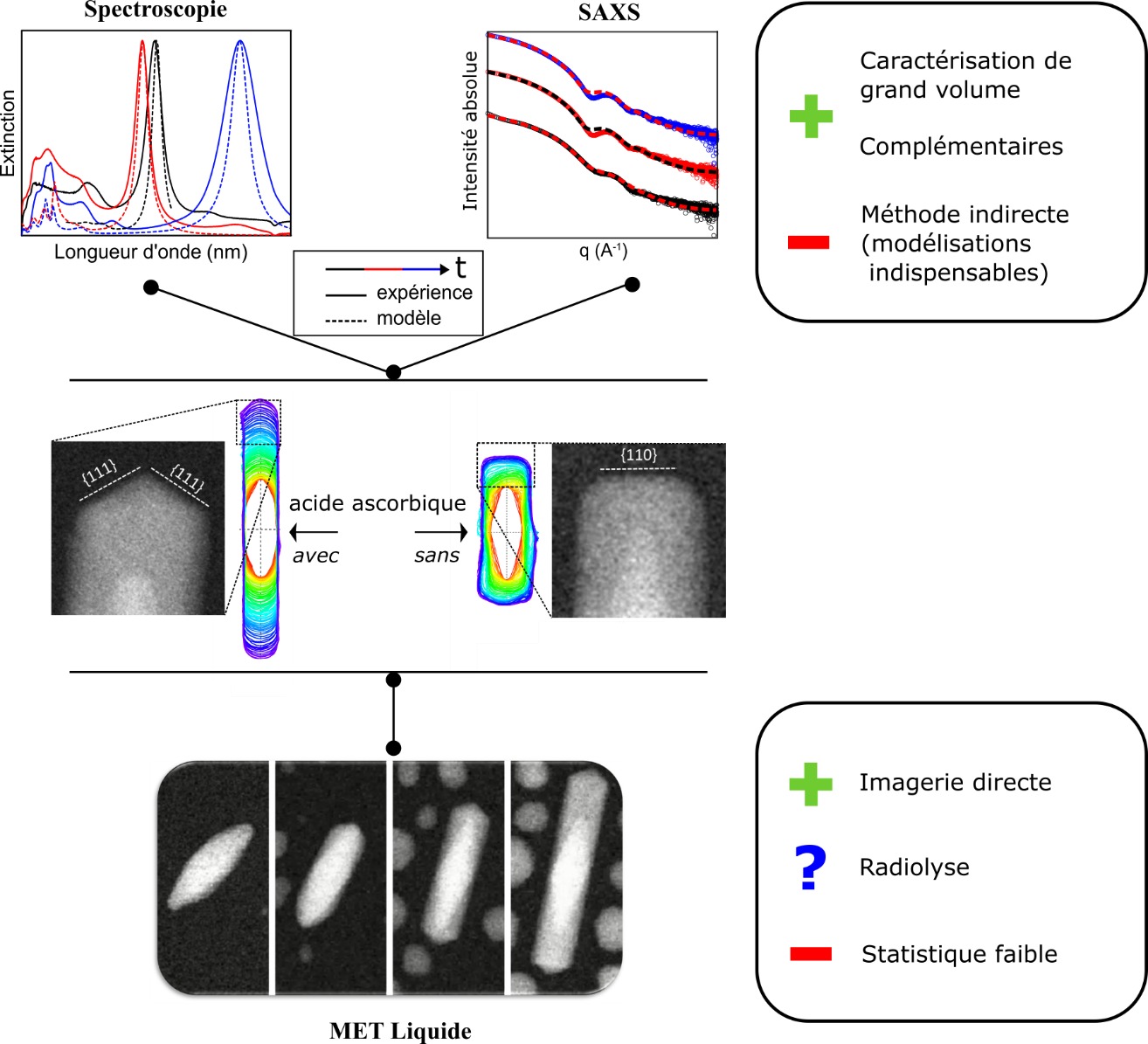 |
Abstract: Rational nanoparticle design is one of the main goals of materials science, but it can only be achieved via a thorough understanding of the growth process and of the respective roles of the molecular species involved. We demonstrate that a combination of complementary techniques can yield novel information with respect to their individual contributions. We monitored the growth of long aspect ratio silver rods from gold pentatwinned seeds by three in situ techniques (small-angle x-ray scattering, optical absorbance spectroscopy and liquid-cell transmission electron microscopy). Exploiting the difference in reaction speed between the bulk synthesis and the nanoparticle formation in the TEM cell, we show that the anisotropic growth is thermodynamically controlled (rather than kinetically) and that ascorbic acid, widely used for its mild reductive properties plays a capping role, by stabilizing the {100} facets of the silver cubic lattice, in synergy with the halide ions. This approach can be easily applied to a wide variety of synthesis strategies. |
Plasmonic NPs patchwork
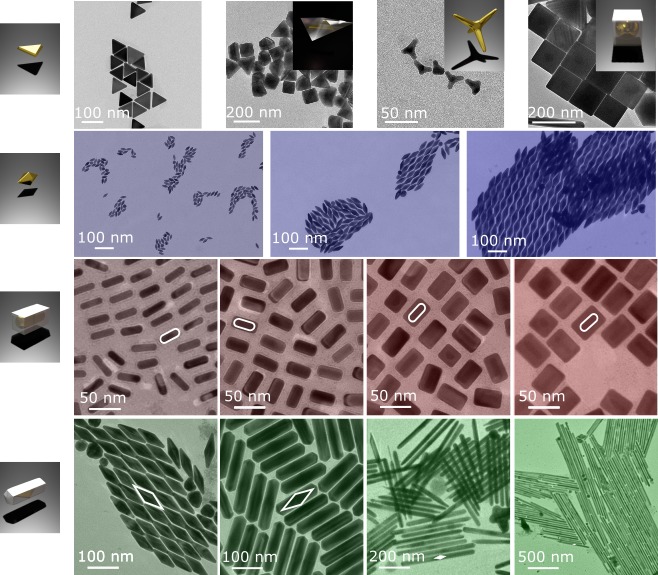 |
Selection of TEM images of Au or Au@Ag NPs with various morphology. The colors distinct series of nanocrystal: gold bipyramids of different size (purple), Au@Ag nanorods of varying shell thickness (red), Au@Ag bipyramids of varying shell length (green). |
Happy new year!
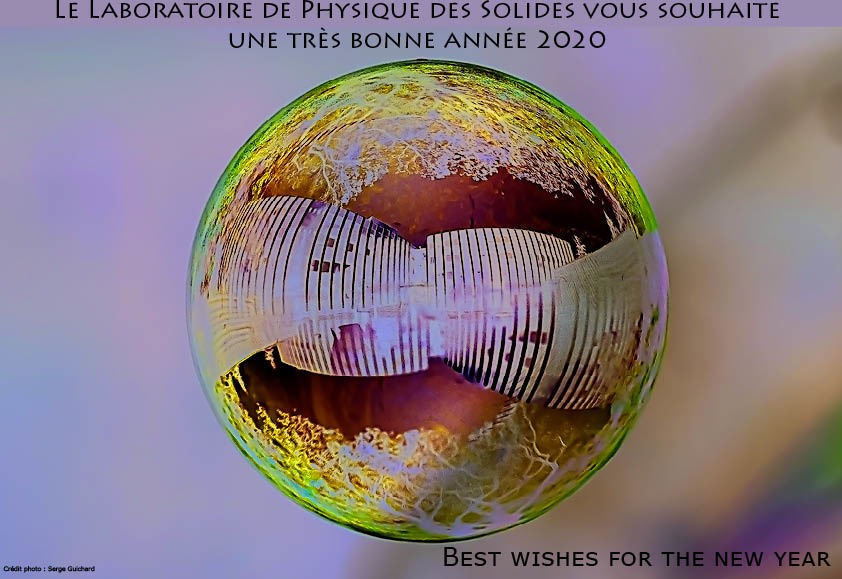
Master intership opportunities
14/11/2019
We are looking for motivated candidates for master 2 internships.
One topic concern the continuation of the intership of Kinanti Aliyah (M2 SERP Chem), about following in real time Au@Ag nanoparticles growth. You can find information about the techniques by reading this preprint: https://doi.org/10.26434/chemrxiv.9994940.v1
The other topic is about resolving the 3D structure of plasmonic supercrystals and study the resulting collective optical properties by Surface Enhanced Raman Scattering (SERS) spectroscopy.
If one of those subjects interest you, please contact us.
Multiscale deposition of noble metal nanoparticles
| 2018-09-27 |
Building nanoscale devices is a crucial step towards the success of nanotechnologies. The assembly of colloidal nanoparticles is a technology in development that may outperform standard lithography techniques in the future. Three-dimensional materials with possibly sub-nanometric inter-distances would be easily manufactured this way. Many groups work towards this goal, but some challenges still need to be addressed, such as the propagation of the order to large length scales. In this work, we demonstrate the organization of anisotropic nanoparticles with controlled local order, which spans the whole sample area.
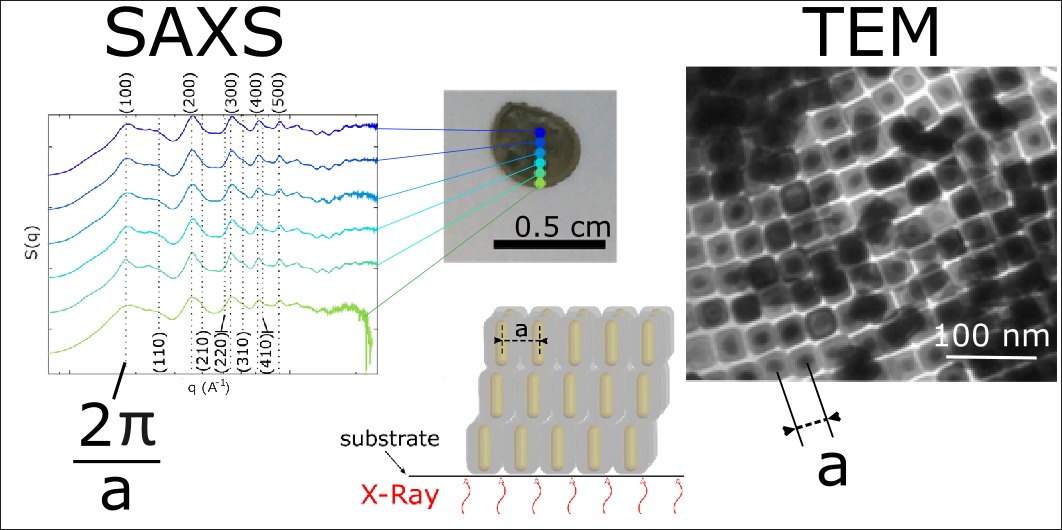
Two complementary techniques (SAXS and TEM) are used to characterize assemblies of Au/Ag heterostructures. In SAXS, the spot size is macroscopic, about 500×200 µm², while in TEM the characterization is made locally, over hundreds of nanometers. The nanoparticles are pointing toward us in the TEM image, organized here in a square in-plane arrangement that can be modulated according to their cross-section.
In this work we used hybrid Au/Ag particles due to their fascinating optical properties. These nanoobjects consist of gold nanorods encased in silver shells with a thickness that can be controlled from a few atomic layers to tens of nanometers. The section of the nanoparticle, initially octagonal, becomes square for a sufficiently thick silver shell. We aimed at studying the impact of the morphological changes of the building blocks on their assembly into superlattices. Usually, nanoparticle assemblies are characterized locally by transmission electronic microscopy (TEM) and give only a limited picture of the assembly on a larger scale. In addition, we used Small Angle X-Ray Scattering (SAXS) to scan the sample area with a probe having much larger dimensions than the nanoparticles. This structural study shows that the nanorods are oriented in the same direction over the whole sample area, thanks to a well-chosen surface chemistry. Furthermore, hexagonal or square phases were formed depending on the octagonal or square cross section of the nanoparticles respectively, demonstrating a control of the multi-scale organization in the system.
Reference: C. Hamon, C. Goldmann and D. Constantin, Nanoscale, 2018, DOI: 10.1039/C8NR06376A.
1 PhD position (ANR)
2018-04-06
Spontaneous organization of mineral nanoparticles
The recent expansion of the field of “chimie douce” (soft chemistry) has led to a wide variety of anisotropic nanoparticles of all kinds of nature and shape (nanotubes, nanosheets, nanorods, etc.). These nanoparticles can often be dispersed in water or in organic solvents as colloidal suspensions. Quite often, these suspensions spontaneously organize in liquid-crystalline phases of different types (nematic, lamellar, columnar …).1,2 Moreover, these suspensions can also be destabilized to produce aggregates with well-defined structures.3-5 These two kinds of phenomena are very useful to manipulate and organize nanoparticles in order to obtain original physical properties. For example, by applying electric or magnetic fields, we can align anisotropic nanoparticles and even sometimes order them on a lattice.
At this moment, we have suspensions of various nanoparticles (clay and H3Sb3P2O14 nanosheets, imogolite nanotubes, CdSe and CeF3 nanoplatelets …) whose phase diagrams and original physical properties still need to be fully explored. This thesis will take place at the LPS which is a joint research unit of CNRS and University Paris-Saclay, specialized in condensed-matter physics. This PhD topic belongs to a more general project, funded by ANR, which aims at using the properties of these nanoparticles to elaborate sensors to monitor water quality.
[1] E.Paineau et al, Liquid Crystals Reviews, 1, 110 (2013).
[2] E.Paineau et al, Nature Communications, 7, 10271 (2016).
[3] B.Abécassis et al, Nanoletters, 14, 710 (2014).
[4] S.Jana et al, Angewandte Chemie, 55, 9371 (2016).
[5] S.Jana et al, Science Advances, 3, e1701483 (2017).
Techniques: X-ray scattering in-house and at large synchrotron radiation facilities (SOLEIL, ESRF), optical and electron microscopies, UV-vis spectroscopies, classical laboratories techniques of sample elaboration.
Required profile: Good level physicist or physical chemist. This thesis in experimental physics / physical chemistry will nevertheless involve a strong collaboration with chemists and theorists.
Funding: Project funded by ANR
Thesis advisors: Patrick Davidson, Jean-Christophe Gabriel
e-mail: patrick.davidson@u-psud.fr
2 PhDs positions opening
| 2018-01-30 |
The 2018 doctoral award campaign of the Ministry of Higher Education, Research and Innovation (MESRI in french) is open for ED 2MIB.
It takes place in 4 phases:
2/ Selection of only one candidate for each project before April 30th
3/ Audition of the candidates by the CIM Pole Jury of the ED (May 18th)
4/ Validation and publication of the results by the ED (June 15th).
click here for details and application:
subject 1: Nanocomposites plasmoniques: amélioration des propriétés d'interfaces
subject 2: Matériaux structurés innovants: étude structurale par diffusion des rayons X
The surprising self-organization of nanotubes in a very dilute columnar liquid-crystal phase
2017-11-07
Liquid crystals have found wide applications in many fields ranging from detergents to information displays. They are an important class of “soft matter” and they are increasingly being used in the “bottom-up” self-assembly approach of the nano-structuration of materials. Moreover, liquid-crystalline organizations are frequently observed by biologists. A research team of the LPS, in collaboration with researchers from CEA-Saclay (NIMBE-LIONS), has recently discovered that one of the four major lyotropic liquid-crystal phases, the columnar one, is actually much more stable (by a factor 100 in concentration!) than considered up to now.
Nanotubes (or nanorods) in colloidal suspensions form a columnar liquid-crystal when they spontaneously organize parallel to each other, on a two-dimensional lattice perpendicular to their axes, like a bunch of pencils (Figure a). This organization was so far only expected in concentrated suspensions where the nanorods are close to contact. Here, researchers at LPS and LIONS have shown that very dilute suspensions of clay imogolite nanotubes form a columnar liquid-crystal. Imogolites are aluminosilicates (or aluminogermanates) that have raised increasing interest in the last decade. In contrast with carbon nanotubes, they are easily obtained by sol-gel processes at low temperature. Moreover, the presence of hydroxyl groups on their surface makes these nanotubes quite hydrophilic, which allows producing aqueous suspensions.
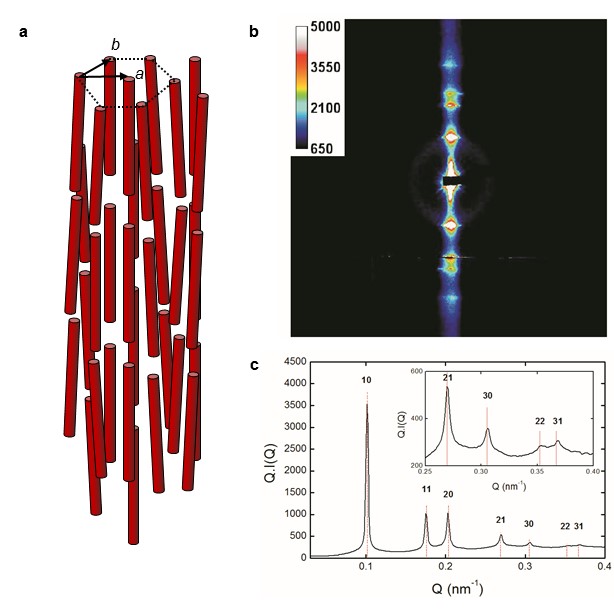
Figure: a) Schematic representation of the organisation of the nanotubes in the columnar hexagonal liquid-crystalline phase (a et b are the unit vectors of the hexagonal lattice) ; b) Small angle X-ray scattering pattern of the columnar phase aligned in an electric field; c) Structure factor showing the reflections (indicated by the red lines) of the hexagonal lattice.
Texture observations of very dilute suspensions (volume fraction ~ 0.3%) by polarized-light microscopy revealed the existence of an unexpected liquid-crystalline phase. Small-angle X-ray scattering measurements, performed at the SOLEIL synchrotron (Swing beamline) showed that this new phase is a columnar hexagonal liquid crystal (Figure b, c).
Despite the high dilution, the nanotubes are perfectly organized on a hexagonal lattice with a spacing (~ 80 nm) fifteen times larger than the nanotube diameter. This dilute liquid-crystal is so fluid that the nanotubes are easily aligned in an electric field, which is a prerequisite for future applications. This work has important implications for the statistical physics of colloidal suspensions of charged rod-like particles, like biopolymers, and their fundamental understanding. It also opens new perspectives, for instance, in the field of nanocomposite materials where the organization of anisotropic particles is required to improve physical properties.
Reference
Paineau E., Krapf, M.E.M., Amara M.S., Matskova, N.V., Dozov, I., Rouzière S., Thill, A., Launois, P. et Davidson, P.. A liquid-crystalline hexagonal columnar phase in highly-dilute suspensions of imogolite nanotubes. Nat. Commun., 7, 10271 (2016)
Contacts
Erwan Paineau (erwan-nicolas.paineau@u-psud.fr)
Patrick Davidson (patrick.davidson@u-psud.fr)
Laboratoire de Physique des Solides, CNRS, Univ. Paris Sud, Université Paris Saclay, 91405 Orsay cedex, France
Review article free to download
2017-11-07
We are pleased to share our review article "Colloidal Design of Plasmonic Sensors Based on Surface Enhanced Raman Scattering", published in Journal of Colloid and Interface Science, is now available online and free to download until December 26, 2017. This is a joint work with Luis Liz Marzan (CIC Biomagune, Spain). You can access the article by cliking on the following link: https://authors.elsevier.com/a/1W0BD4-sDFY5b.
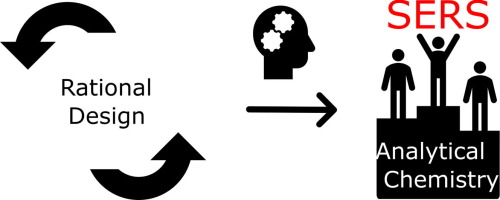
Abstract: This feature article focuses on the use of colloid chemistry to engineer metallic nanostructures toward application in surface enhanced Raman scattering (SERS) sensing, in particular for ‘real-life’ applications, where the analyte may be present in complex mixtures. We present a broad summary of the field, including recent advances that have been developed during the past 10 years. Real-life applications require a rational design and we aimed at identifying the key elements involved in it. The discussion is centered around colloidal plasmonic nanoparticles and therefore we start from the library of morphologies that have been reported in the literature. To complete the picture, colloidal self-assembly, surface chemistry and the combination with materials science techniques are highlighted. Considering the progress in the field, SERS may ultimately realize its full potential as an ultrasensitive tool for routine analytical applications.
